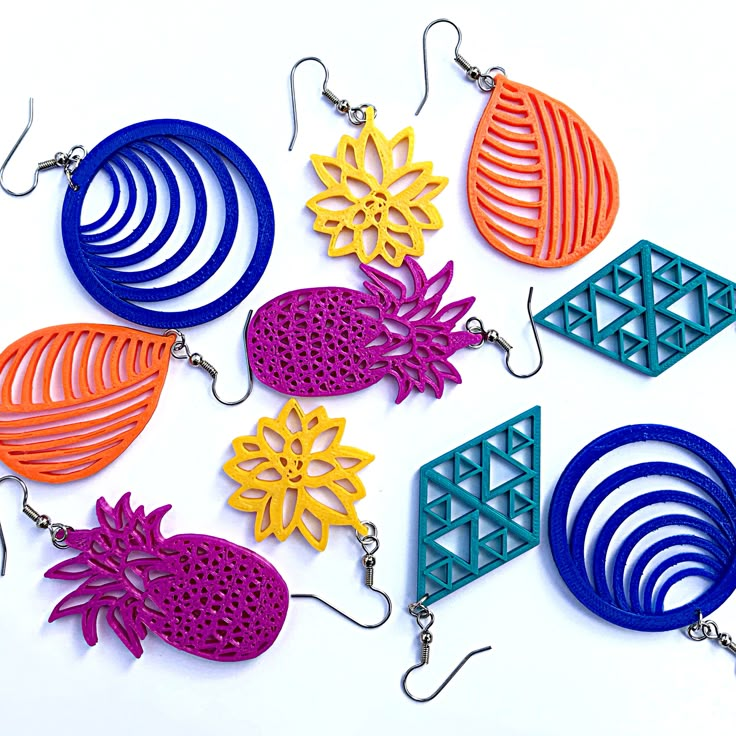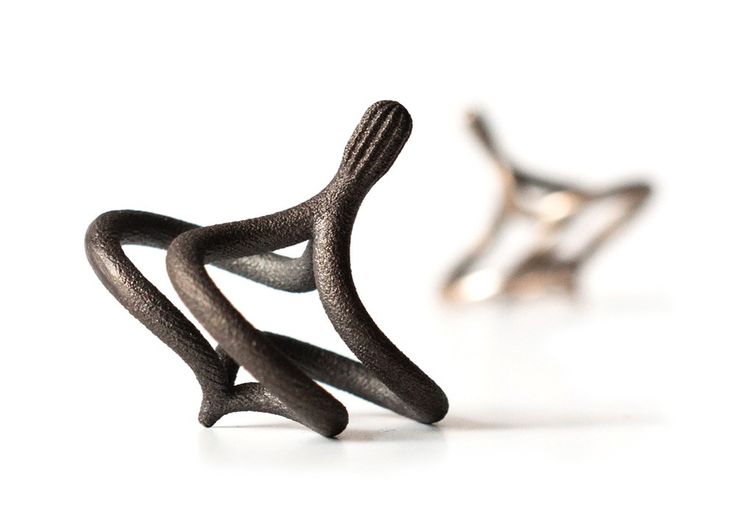Best 3d printers under 250
Top 8 printers under $300
This guide features a shortlist of some of the best 3D printers available for under 300 dollars. Our handpicked selection is followed by an easy 3D printer buying guide with tips and things you should look out for. If you make a purchase through one of our affiliate links, we may earn a small commission to support our content and site.
Last update January 5, 2022
This fall, we removed some outdated products and added some brands such as Longer3D, FlashForge, and FLSUN. Prices have been crunched down since last time, too, so we also updated the guide in that regard.
Table of contents
What is the best budget 3D printer under $300?
The 8 best cheap 3D printers under $300
A10M
Mega-S
X-One 2
Ender 3 V2
MP Select Mini V3
LK4
Magic
Finder
Pre-assembled 3D printers vs DIY 3D printer kits
Enclosed versus open frame
Community support
Build volume
Automatic calibration
Prusa i3 clones and the RepRap legacy
Top cheap Kickstarter 3D printer fails
FAQ
What is the best budget 3D printer under $300?
We scoured the web to find the 8 best cheap 3D printers under $300 and share our final selection in this article.
Since 2016, we’ve been noticing a “race-to-the-bottom” trend where 3D printer prices are driven down. Many startups and (mostly Chinese) manufacturers are competing to make the cheapest 3D printers on the market.
Low prices often used to be synonym with poor quality, but that’s no longer the case: the budget 3D printers in our list all provide a great value for the money. It’s more and more common to see user-friendly features from higher-end machines trickle down to the cheaper printers.
That said, 3D printers under $300 are typically not professional-grade machines and often require some level of technical knowledge and patience. They almost always come as kits to be assembled and are recommended for tinkerers and makers, but also beginners with a small budget.
All of the 3D printers in this guide are filament-based. If you’re looking for a cheap resin 3D printer, head over here.
The 8 best cheap 3D printers under $300
| Brand | Product | Build size | Country | Price Approximate starting prices based on supplier-provided information and public data. | |
|---|---|---|---|---|---|
| Creality | Ender 3 V2 | 220 × 220 × 250 mm8.66 × 8.66 × 9.84 in | – | $ 155155 €140 £22,588 ¥ | Contact |
| JGMAKER | Magic | 220 × 220 × 250 mm8.66 × 8.66 × 9.84 in | – | $ 200206 €181 £29,146 ¥ | Contact |
| Monoprice | MP Select Mini V3 | 120 × 120 × 120 mm4.72 × 4.72 × 4.72 in | – | $ 220227 €199 £32,061 ¥ | Contact |
| Longer3D | LK4 | 220 × 220 × 250 mm8.66 × 8.66 × 9.84 in | – | $ 270278 €244 £39,348 ¥ | Contact |
| Geeetech | A10M | 220 × 220 × 260 mm8.66 × 8.66 × 10.24 in | – | $ 280299 €253 £40,805 ¥ | Contact |
| Qidi Tech | X-One 2 | 145 × 145 × 145 mm5.71 × 5.71 × 5.71 in | – | $ 298307 €270 £43,428 ¥ | Contact |
| ANYCUBIC | Mega-S | 210 × 210 × 205 mm8. 27 × 8.27 × 8.07 in 27 × 8.27 × 8.07 in | – | $ 299308 €271 £43,574 ¥ | Contact |
| FlashForge | Finder | 140 × 140 × 140 mm5.51 × 5.51 × 5.51 in | – | $ 299308 €271 £43,574 ¥ | Contact |
Expand to see more specs
The products in the table are ranked by price (low to high).
| Product | Brand | Build size | Price Approximate starting prices based on supplier-provided information and public data. Prices may vary by region, over time and do not include additional products or services (taxes, shipping, accessories, training, installation, …). | |
|---|---|---|---|---|
| Ender 3 V2 | Creality | 220 × 220 × 250 mm8.66 × 8.66 × 9.84 in | $ 155155 €140 £22,588 ¥ | Contact manufacturer |
| Magic | JGMAKER | 220 × 220 × 250 mm8.66 × 8.66 × 9.84 in | $ 200206 €181 £29,146 ¥ | Contact manufacturer |
| MP Select Mini V3 | Monoprice | 120 × 120 × 120 mm4.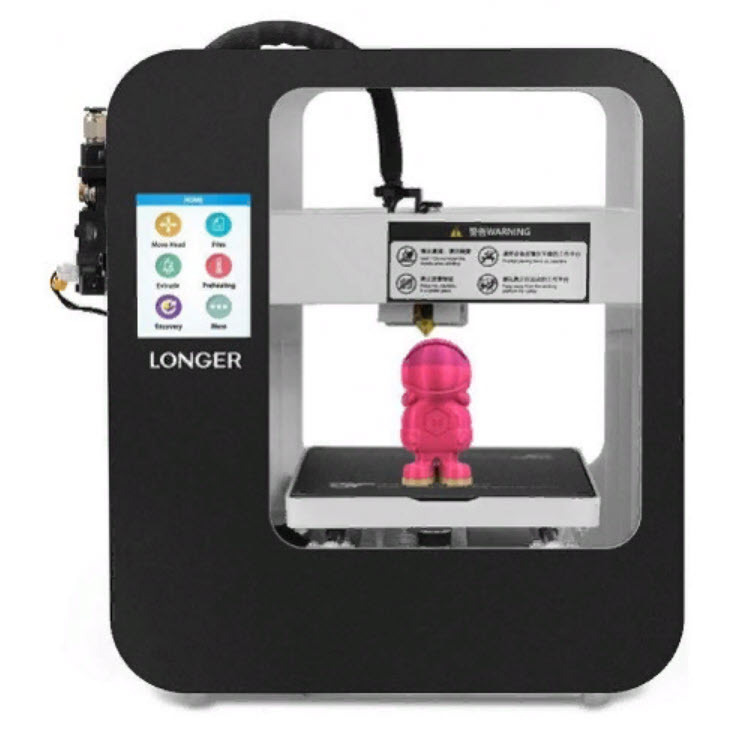 72 × 4.72 × 4.72 in 72 × 4.72 × 4.72 in | $ 220227 €199 £32,061 ¥ | Contact manufacturer |
| LK4 | Longer3D | 220 × 220 × 250 mm8.66 × 8.66 × 9.84 in | $ 270278 €244 £39,348 ¥ | Contact manufacturer |
| A10M | Geeetech | 220 × 220 × 260 mm8.66 × 8.66 × 10.24 in | $ 280299 €253 £40,805 ¥ | Contact manufacturer |
| X-One 2 | Qidi Tech | 145 × 145 × 145 mm5.71 × 5.71 × 5.71 in | $ 298307 €270 £43,428 ¥ | Contact manufacturer |
| Mega-S | ANYCUBIC | 210 × 210 × 205 mm8.27 × 8.27 × 8.07 in | $ 299308 €271 £43,574 ¥ | Contact manufacturer |
| Finder | FlashForge | 140 × 140 × 140 mm5.51 × 5.51 × 5.51 in | $ 299308 €271 £43,574 ¥ | Contact manufacturer |
Overview of our budget 3D printer selection
The Geeetech A10M is the only 3D printer under $300 offering multi-color 3D printing capacities. Based on the same architecture that made the A10 a success, the A10M 2-in-1 extruder allows you to 3D print with different colors via 4 modes: single color, dual color, graded color, and mixed color.
Based on the same architecture that made the A10 a success, the A10M 2-in-1 extruder allows you to 3D print with different colors via 4 modes: single color, dual color, graded color, and mixed color.
Combined with a massive build volume, multi-color 3D printing is definitely an attractive option. It’s important to note though that this printer is mostly for advanced users and requires fine-tuning (also, this is not a full-color 3D printer).
Contact manufacturer Add to comparison
The ANYCUBIC Mega-S stands out in this list of the best 3D printers under $300. Its well-thought suspended filament rack on the side allows to save space, and the printer is fitted with a high-quality Titan extruder.
The Mega-S is very easy to assemble and intuitive operate thanks to its user-friendly touch screen. The ANYCUBIC Ultrabase, its durable proprietary build plate, offers excellent adhesion and enables easy print removal. Overall, the ANYCUBIC Mega-S is a pretty decent cheap 3D printer!
Contact manufacturer Add to comparison
This closed-frame 3D printer comes already assembled.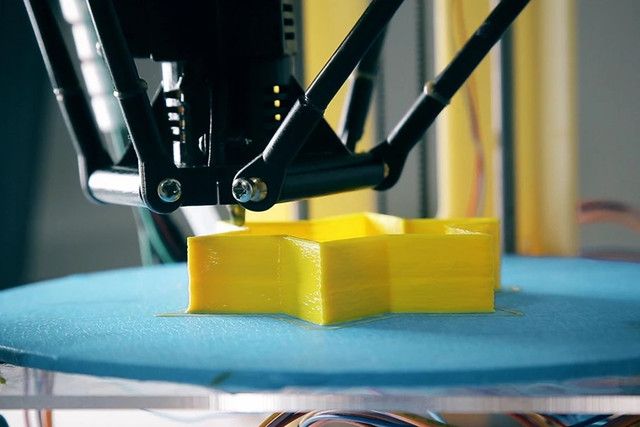 It offers numerous features packed in a sturdy upgraded design. The latest version of the X-One 2 includes an MK10 extruder, a heated aluminium print bed, and a user-friendly touchscreen.
It offers numerous features packed in a sturdy upgraded design. The latest version of the X-One 2 includes an MK10 extruder, a heated aluminium print bed, and a user-friendly touchscreen.
The Qidi Tech X-One 2 is a popular choice for all kind of users, from hobbyists to advanced makers looking for the best 3D printer under $300.
Contact manufacturer Add to comparison
The Creality Ender 3 is one of the best-selling 3D printers under $300 (and one of the top rated, too!). The Ender 3 is widely praised as a reliable and easy-to-use 3D printer, suitable for beginners willing to spend some time tinkering their machine and for advanced makers alike.
Its advanced extruder reduces the risk of filament clogging and the Ender 3 also has the capacity to resume printing after a power outage. The user community of this open-source 3D printer is very active, making it easy to find help and share tips on discussion groups.
Contact manufacturer Add to comparison
The Select Mini by Monoprice is a compact desktop 3D printer for beginners. It features automatic bed leveling, a touchscreen, and comes pre-assembled.
It features automatic bed leveling, a touchscreen, and comes pre-assembled.
This version is the third generation of the Monoprice Select Mini 3D printer series.
Contact manufacturer Add to comparison
The LK4 by Longer3D hosts a range of features, including a color touchscreen (two sizes available to choose from), a filament detector, a pause-and-resume print feature, and more.
It offers a good amount of build volume for the price, and comes with a one-year manufacturer guarantee and 24-hour customer support.
Contact manufacturer Add to comparison
The JGMAKER Magic is less popular than its direct competitors but should not be overlooked. Its basic yet sturdy design makes this 3D printer very stable during prints.
The JGMAKER Magic also offers standard features such as a filament run-out detector, a resume printing function, and removable build plate. The Magic’s compact design, with the power supply built in, is the printer’s most notable difference in comparison with the Ender 3.
Contact manufacturer Add to comparison
FlashForge is a popular 3D printer brand for beginners and hobbyists. Their Finder model is a user-friendly option with Wi-Fi, cloud, and USB connectivity and a slide-in build plate.
The printer features automatic bed leveling and safety features for younger-aged users and schools.
Contact manufacturer Add to comparison
3D printer buying guide for a $300 budget
What to look for when buying an entry-level, low-cost 3D printer? In the sub-300 price range, there is not much room for pickiness, but there are still a few aspects that are important to consider.
Pre-assembled 3D printers vs DIY 3D printer kits
DIY 3D printer kits used to be quite complex and time-consuming to build. Today, most of them are delivered partly pre-assembled and only require you to screw three or four parts together in under an hour.
Beginners can easily assemble a kit with little 3D printing knowledge.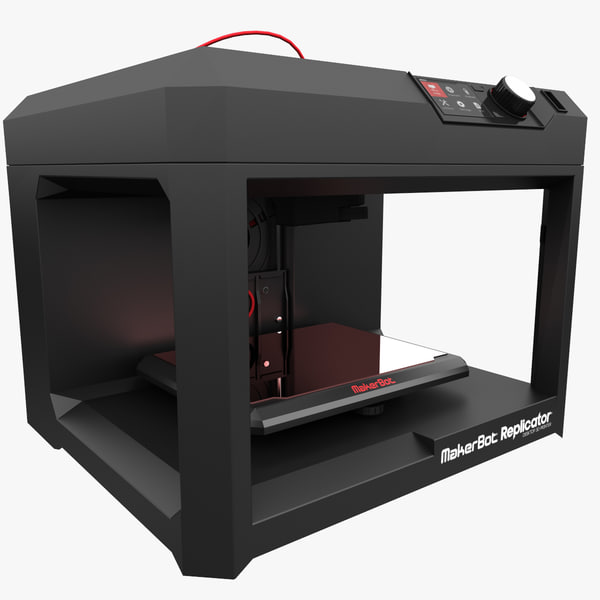 While it’s not always the case with fully pre-assembled printers, most 3D printer kits can be upgraded with extra 3D printed parts.
While it’s not always the case with fully pre-assembled printers, most 3D printer kits can be upgraded with extra 3D printed parts.
Enclosed versus open frame
Many things can interfere with 3D print quality, such as temperature changes and room drafts. Closed frame 3D printers help protect the 3D printing process as well as reduce particle emissions (from melted plastic) and noise.
For PLA prints, an open frame works fine, but ABS 3D printing does require a bit more of a controlled environment.
Help and frequently asked questions can be found on specialized forums and dedicated discussions groups for specific 3D printer models (there are plenty on Facebook).
Our list of the best general 3DP communities provides more information about these forums and groups.
Build volume
The build volume, or maximum size of a 3D print, is an important spec to consider. If the goal is just to discover and experiment with 3D printing then the build size isn’t too critical, unlike if specific parts need to be printed with certain dimensions.
Automatic calibration
3D print accuracy can easily be thrown off if the print bed is the teeniest bit lopsided. Some 3D printers offer automated bed leveling, but many others require manual calibration. An auto-calibration feature can help save time, but it isn’t hard to do it manually.
Other interesting features include:
- Filament sensor (detects if there’s a filament jam)
- Auto resume (saves print progress in case of power failures)
- Wi-Fi connectivity
- Touchscreen
Prusa i3 clones and the RepRap legacy
Many budget 3D printers are based on or are clones of the Original Prusa i3, a design developed by Josef Prusa in 2012.
The Prusa i3 is part of the RepRap (replicating rapid prototyper) project whose initial aim was to develop a low-cost 3D printer able to replicate most of its components using 3D printing.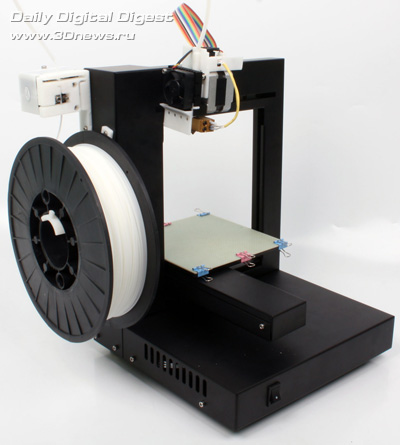 Since its debut in 2005, hundreds of international contributors have joined the project to keep upgrading and optimizing 3D printing for everyone.
Since its debut in 2005, hundreds of international contributors have joined the project to keep upgrading and optimizing 3D printing for everyone.
The blueprints are open source and patent-free. Hence, many manufacturers “cloned” and rebranded the Prusa i3. Josef Prusa is part of the business too and selling 3D printers under his own brand, Prusa Research.
The Original Prusa i3 MK2 by Josef Prusa, one of the best 3D printers available on the desktop 3D printer market.What about low-cost Kickstarter 3D printers?
Some Kickstarter and Indiegogo projects advertise 3D printers at crazy low prices, sometimes under $100! Many of those 3D printer Kickstarter projects have proven to be scams… See below some of the top 3D printer fails on crowdfunding platforms!
Top cheap Kickstarter 3D printer fails
3D printer startups tend to promise amazing products through expensive marketing campaigns to get as many pledges as they can.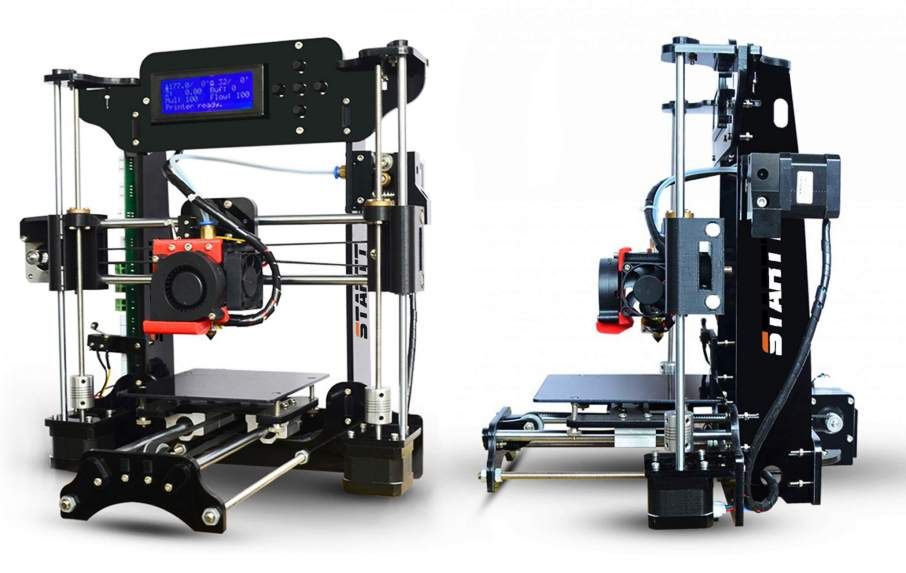 This is not an unusual goal, but when too much effort is put into advertising there is not much left for logistics, especially if the business model is not well prepared.
This is not an unusual goal, but when too much effort is put into advertising there is not much left for logistics, especially if the business model is not well prepared.
TIKO 3D Tiko
- Price: $199
- Amount pledged: almost $3M in March 2015
- Number of backers: 16,538
- What happened: they simply promised too much for too little and found themselves left with no more funds to fulfill their orders. The first backers received their 3D printers, but many remained Tiko-less.
- More information: Tiko 3D Tiko
Rinnovated Design Peachy Printer
- Price: $100
- Amount pledged: over $650,000 after its launch in September 2013
- Number of backers: 4,420
- What happened: one of the two founders embezzled about half of the Peachy Printer funds to build himself a house, forcing the company to lay off its workers and collapse.
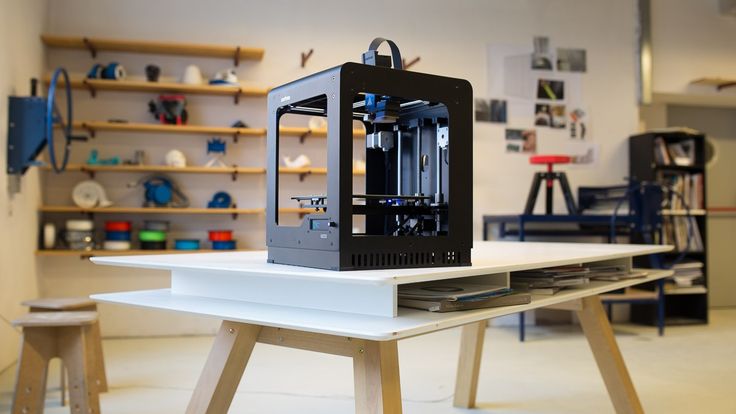
- More information: Rinnovated Design Peachy Printer
Pirate3D Buccaneer
- Price: $300
- Amount pledged: just under $1.5M, and an additional $2M by private investors
- Number of backers: 3,520
- What happened: Pirate3D drowned in their initial success with too many products to deliver and not enough staff. They roguishly started to retail-sell their 3D printer before trying to own up to their backers (which they didn’t).
- More information: Pirate3D Buccaneer
FAQ
What is the best 3D printer for beginners?
The best choice of 3D printer for beginners is an assembled, plug-n-play 3D printers such as the Qidi Tech X-One 2 or the FlashForge Finder.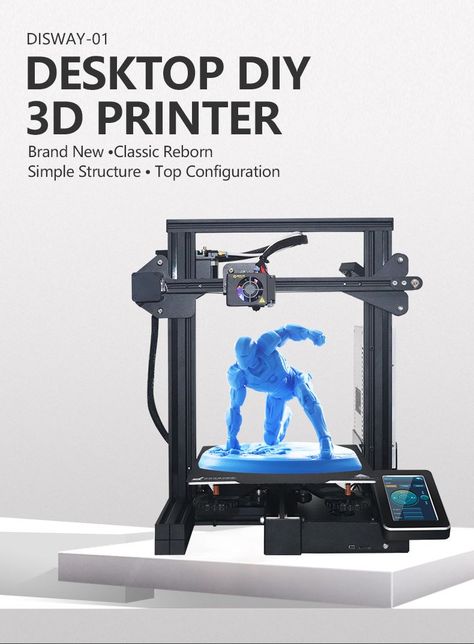 Such 3D printers are easy to operate and offer a great first experience with 3D printing.
Such 3D printers are easy to operate and offer a great first experience with 3D printing.
What’s the best cheap 3D printer kit?
One of the cheap 3D printer kits is the Creality Ender 3. It is easy to assemble and offers great print quality and reliability.
Where to find a cheap 3D printer for sale?
There are plenty of affordable 3D printers for sale on Amazon, with prices starting under $200 even for assembled 3D printers.
The 9 Best 3D Printers under $300 in 2022 – Clever Creations
The lower prices of 3D printers have made 3D printing accessible for many. There are lots of options available in the budget 3D printer segment that are great for anyone who’s looking to get into the hobby. However, with so many options to choose from, it can easily get confusing to find the budget printer that best suits your needs.
In this article, we’ll go over our favorite picks for the best 3D printer under $300.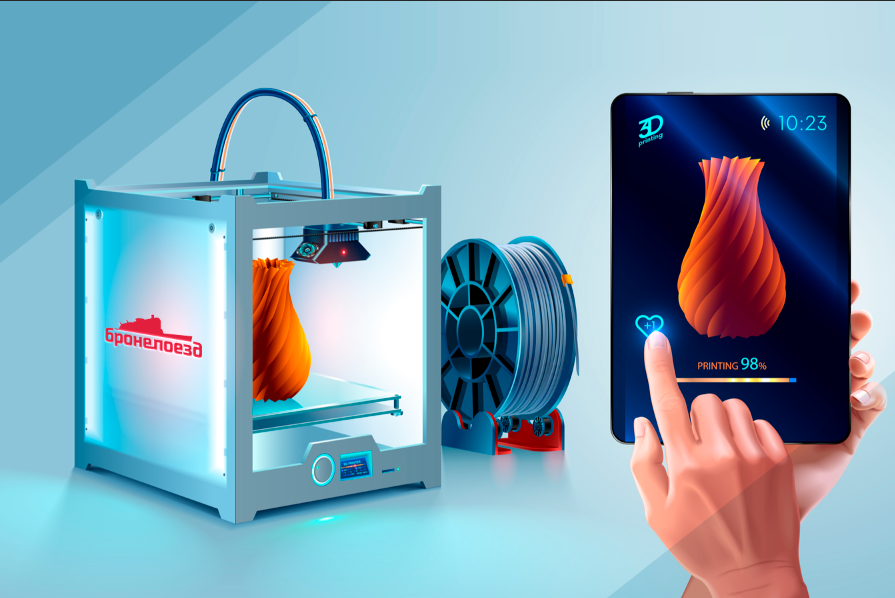 We’ve classified these printers into various categories and listed some things that you should consider when making your purchasing decision.
We’ve classified these printers into various categories and listed some things that you should consider when making your purchasing decision.
| 3D Printer Under 300 | Summary | Type | Build Volume | Price (~) | Best Offer |
|---|---|---|---|---|---|
| Anycubic Kobra | Best overall | FDM | 220x220x250 mm | $271 | Anycubic |
| Creality Ender 3 | Best on a budget | FDM | 220x220x250 mm | $189 | Creality3D |
| Anycubic Photon Mono | Best budget resin | Resin | 130x80x165 mm | $239 | Anycubic |
| Creality Ender 3 V2 | Most aftermarket upgrades | FDM | 220x220x250 mm | $279 | Creality3D |
| Flashforge Finder | Best for beginners | FDM | 140x140x140 mm | $279 | Flashforge |
| Anycubic Mega S | Best material compatibility | FDM | 210x210x205 mm | $249 | Anycubic |
| Sovol SV01 | Largest print area | FDM | 280x240x300 mm | $299 | Sovol3D |
| Artillery Genius | Most silent | FDM | 220x220x250 mm | $299 | AliExpress |
| Monoprice Mini Delta V2 | Best Delta printer | FDM | ø110 x 120 mm | $179 | Amazon |
Best 3D printers under $300 in 2022
Anycubic Kobra
Best overall
Check Price
AmazonAnycubicAliExpress
The Anycubic Kobra is the basic model of Anycubic’s new Kobra series of FDM 3D printers.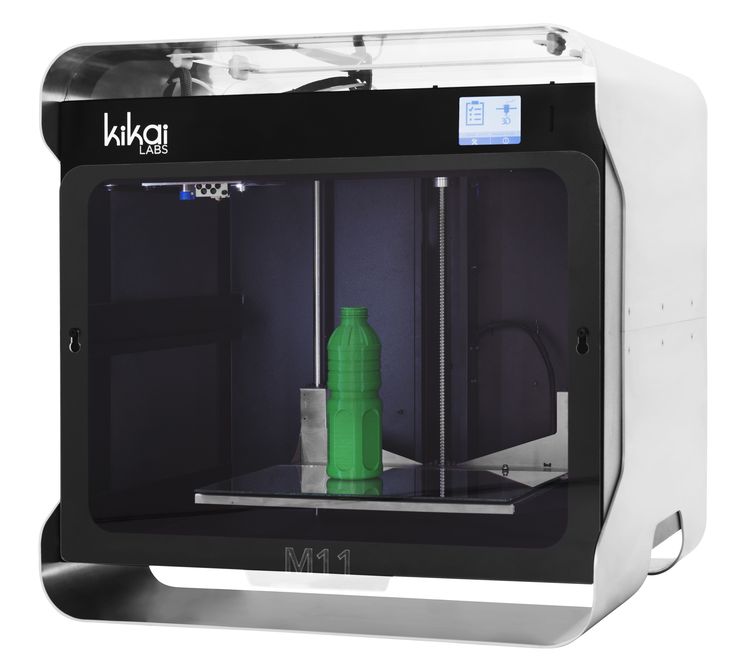 It comes in a brand new industrial design and is equipped with advanced features to keep it up to date with current 3D printing standards.
It comes in a brand new industrial design and is equipped with advanced features to keep it up to date with current 3D printing standards.
Anycubic’s self-developed automatic bed leveling helps you with the initial bed leveling process. It makes sure that you get a smooth first layer and that your prints stick to the bed with ease. The direct extruder gives you increased control over the filaments and lets you print with flexible materials such as TPU and TPE.
Its PEI coated spring steel build platform is designed for improved adhesion and the easy removal of your 3D prints. The large 4.3-inch vertical touch screen lets you easily interact with the 3D printer and makes navigating through the user interface a smooth experience.
For $300, it is an bargain and a step above the Creality Ender 3 V2. It is a good choice for beginners, students, and hobbyists who need a budget FDM 3D printer that delivers good printing quality.
Recommended:
Anycubic Kobra Review: The Best Budget 3D Printer?
Standout Features
- 25-point automatic bed leveling
- Direct drive extruder
- Spring steel platform
Technical Details | |
|---|---|
| Print volume | 220 x 220 x 250 mm |
| Bed leveling | Automatic |
| Heated print bed | Yes |
| Filament diameter | 1.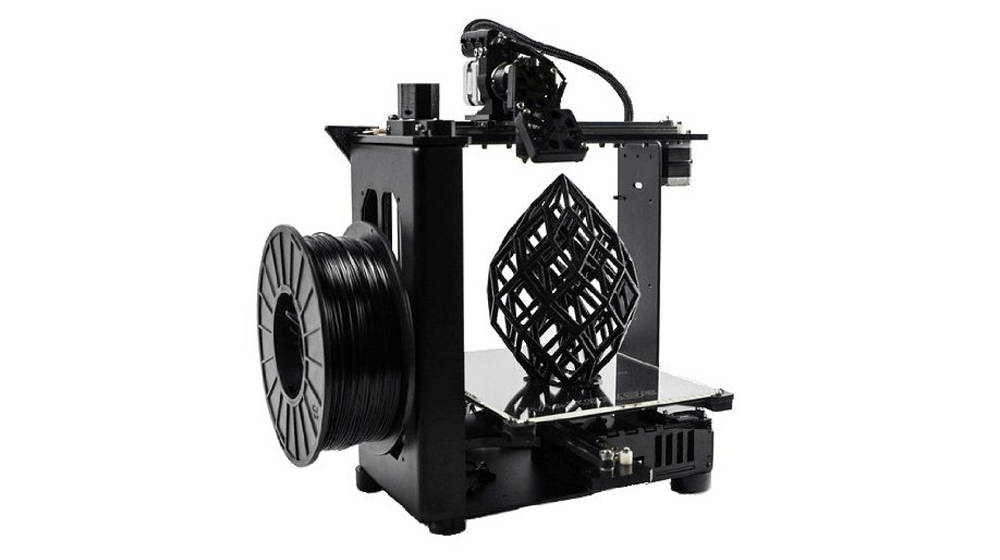 75 mm 75 mm |
| Max hotend temperature | 260 °C |
What We Like
- Easy print removal
- Intuitive user-friendly touch screen
- Easy assembly process
- Wide material compatibility
Could Be Better
- Noisy operation
- Limited slicer support
- Plasticky feel
Find Anycubic Kobra at
AmazonAnycubicAliExpress
Creality Ender 3
Best on a budget
Check Price
AmazonCreality3DComgrow
While the Ender 3 V2 is still a good contender for the best 3D printer under $300, its predecessor, the Creality Ender 3, remains the best budget 3D printer in this price class. Even though it’s been over 3 years since it was first released, the Ender 3 remains a popular choice in the budget segment.
The Ender 3 has all the functionalities that you would expect from a basic 3D printer. It comes with a build volume of 220x220x250mm and a heated print bed with a sticky Buildtak-like printing surface. It is beginner-friendly and provides a decent printing quality from the start.
Since it is a popular 3D printer, there are tons of user guides, tutorials, and community forums for the Ender 3. There are many mods and upgrades available for the Ender 3, which makes it a versatile option.
If you’re on a budget, want a good 3D printer, and are open to fiddling a little to get the perfect results, the Ender 3 is a great choice for you.
Standout Features
- Heated build plate
- Sticky print surface
- Beginner-friendly
Technical Details | |
|---|---|
| Price | $189 |
| Print volume | 220x220x250 mm |
| Bed leveling | Manual |
| Heated print bed | Yes |
| Supported slicers | Cura, Simplify3D, PrusaSlicer, etc. |
| Filament diameter | 1.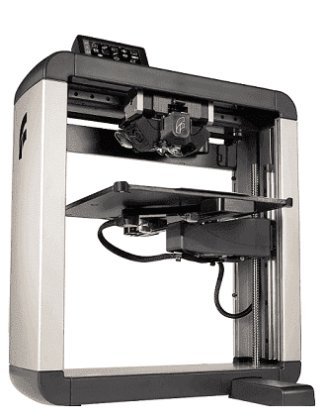 75 mm 75 mm |
| Max hotend temperature | 240°C |
What We Like
- Lots of community support
- Compatible with aftermarket upgrades
- Great value for the money
Could Be Better
- Open frame design
- Cheap plastic extruder
Find Creality Ender 3 at
AmazonCreality3DComgrow
Anycubic Photon Mono
Best budget resin
Check Price
AmazonAnycubicGeekbuyingAliExpress
The cost of resin 3D printers has come down drastically within the last few years and 3D printers like the Anycubic Photon Mono are a testament to this. The Photon Mono is a cheap, entry-level resin 3D printer from Anycubic.
It comes with a sharp 2K resolution monochrome LCD screen, which allows you to reproduce fine details. The Photon Mono has a decent build volume of 130x80x165 mm. This is less than the other options in the 3D printers under $300 segment, but that is to be expected of a printer that uses 3D printer resin instead of filament.
To guarantee precision and stability during the printing process, it comes with a quality linear rail for the Z-axis.
The main advantage of resin 3D printers is the superb print quality that they offer. If you are interested in 3D printing (D&D) minis and figurines, you are best off with a resin 3D printer. If that’s what you’re looking for, and you don’t want to spend too much, the Anycubic Photon Mono is a great choice.
Standout Features
- Small and compact size
- 2K resolution monochrome LCD screen
- Easy to replace FEP film
Technical Details | |
|---|---|
| Price | $239 |
| Print volume | 130x80x165 mm |
| Bed leveling | Manual |
| Supported slicers | Anycubic Photon Workshop |
| Material | 405nm UV Resin |
What We Like
- Budget-friendly and for beginners
- Reproduces fine details with accuracy
- Good community support
Could Be Better
- Proprietary slicing software
- Small touchscreen
Find Anycubic Photon Mono at
AmazonAnycubicGeekbuyingAliExpress
Creality Ender 3 V2
Most aftermarket upgrades
Check Price
AmazonCreality3DComgrow
Until the release of the Anycubic Kobra, we considered the Creality Ender 3 V2 to be the best 3D printer under $300.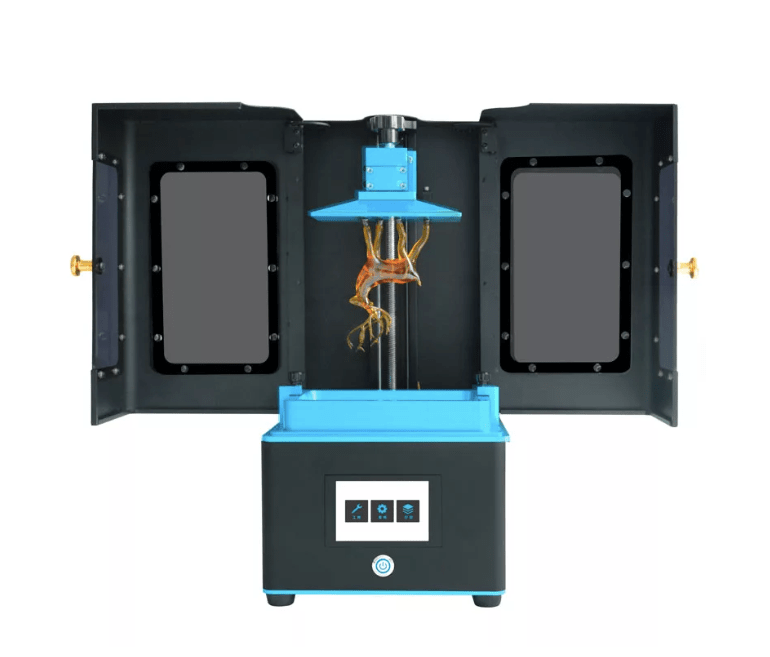 It is a worthy successor to the popular Ender 3 and comes with an updated look and brand new spec sheet that suits the current 3D printing standards.
It is a worthy successor to the popular Ender 3 and comes with an updated look and brand new spec sheet that suits the current 3D printing standards.
The Ender V2 has a sturdy aluminum body with a generous heated bed of 220 x 220 mm. It comes with a color screen with an updated UI, which lets you navigate the various functions of this budget 3D printer with ease. The addition of a toolbox, XY belt tensioners, and an extruder knob are some of the neat little things that make the Ender V2 stand out.
The Ender V2 features an updated 32-bit motherboard with TMC 2208 stepper motor drivers. It also comes with a UL-certified power supply for added safety and faster heat times.
On top of that, you can find great community support with tons of tutorials and guides available for upgrading your Ender 3 V2. In short, this printer has everything you would expect from a sub $300 3D printer and then some.
Standout Features
- Color screen with redesigned UI
- TMC 2208 stepper motor drivers
- 350W Meanwell Power Supply
Technical Details | |
|---|---|
| Price | $279.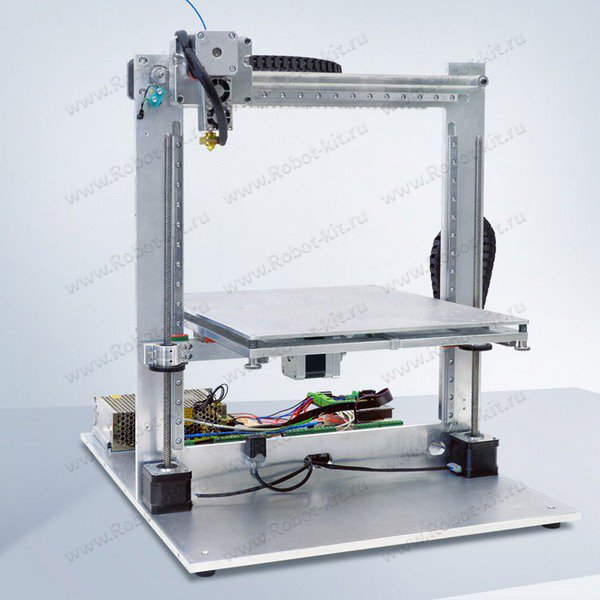 00 00 |
| Print volume | 220x220x250 mm |
| Bed leveling | Manual |
| Heated print bed | Yes |
| Supported slicers | Cura, Simplify3D, PrusaSlicer, etc. |
| Filament diameter | 1.75 mm |
| Max hotend temperature | 240°C |
What We Like
- Easy to use and beginner-friendly
- Great print quality out of the box
- Components can be upgraded with ease
Could Be Better
- Limited material compatibility
- Lack of enclosure
Find Creality Ender 3 V2 at
AmazonCreality3DComgrow
Flashforge Finder
Best for beginners
Check Price
AmazonFlashforge
The Flashforge Finder is a plug-n-play kind of 3D printer. It takes less than maybe 30 minutes to set it up and start 3D printing.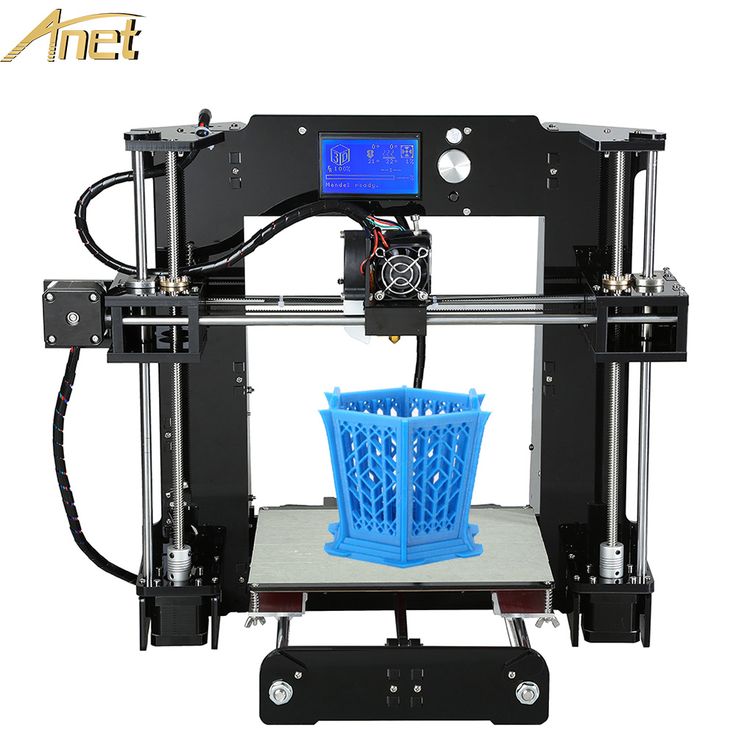 The features and ease of use make the Finder a great fit for beginners in 3D printing.
The features and ease of use make the Finder a great fit for beginners in 3D printing.
The Finder has a closed frame with a sturdy build, which gives it a nice boxy look. The filament spool is neatly tucked inside the printer body. This makes it an ideal 3D printer to use in a classroom setting and as a printer to carry around anywhere with ease.
This 3D printer under 300 comes with a user-friendly touch screen with a neatly laid out interface. It makes it easy to control the printer and is especially easy for kids and people with disabilities to use.
One limitation of the Flashforge Finder is that it uses its proprietary slicing software – Flashprint – for preparing models. However, this software is finely tuned to the Finder and optimized so that it’s easy to use. In it, you can find preloaded profiles to prepare a file, or you can fine-tune some of the major settings to your needs. Flashforge has optimized the entire user experience of the Finder for people who are just getting started with 3D printing.
Standout Features
- Responsive touchscreen
- USB and Wi-Fi connectivity
- Slide-in build plate
Technical Details | |
|---|---|
| Price | $279 |
| Print volume | 140x140x140 mm |
| Bed leveling | Manual |
| Heated print bed | No |
| Supported slicers | Flashprint |
| Filament diameter | 1.75 mm |
| Max hotend temperature | 220°C |
What We Like
- Quick setup with minimal preparation
- Safe to use around kids
- Easy to use
Could Be Better
- No heated build plate
- The built-in spool holder is small
- Limited functionality in the Flashprint software
Find Flashforge Finder at
AmazonFlashforge
Anycubic Mega S
Best material compatibility
Check Price
AmazonAnycubicAliExpressGeekbuying
Typical 3D printers under $300 have limited material compatibility because of the hotends that they use. These hotends reach relatively low maximum temperatures and limit the 3D printing materials that they are compatible with to PLA and sometimes ABS. The Anycubic Mega S 3D printer’s hotend, on the other hand, can reach a maximum temperature of 260°C.
These hotends reach relatively low maximum temperatures and limit the 3D printing materials that they are compatible with to PLA and sometimes ABS. The Anycubic Mega S 3D printer’s hotend, on the other hand, can reach a maximum temperature of 260°C.
The higher hotend temperature makes the Anycubic Mega S compatible with PLA, ABS, TPU, HIPS, PETG, and even wood filaments. To complement this, it has a solid metal body with a large build volume of 210 x 210 x 205 mm. You also get an easy-to-use touchscreen and a Titan extruder, which is almost unheard of for 3D printers under $300.
The Titan extruder offers more precise extrusion and allows you to print better with flexible filaments. Overall, when compared to its competitors in terms of filament compatibility, what you get with the Anycubic Mega S is definitely a step above the competition.
Standout Features
- Easy assembly
- Touchscreen for easy navigation
- Filament sensor
Technical Details | |
|---|---|
| Price | $249 |
| Print volume | 210x210x205 mm |
| Bed leveling | Manual |
| Heated print bed | Yes |
| Supported slicers | Cura |
| Filament diameter | 1. 75 mm 75 mm |
| Max hotend temperature | 260°C |
What We Like
- Compatible with many filaments
- Easy to set up and use
- Compact and sturdy construction
Could Be Better
- No automatic bed leveling
- Lack of Wi-Fi connectivity
Find Anycubic Mega S at
AmazonAnycubicAliExpressGeekbuying
Sovol SV01
Largest print area
Check Price
AmazonSovol3D
The Sovol SV01 is probably the 3D printer under 300 that comes with the largest build volume: 280x240x300 mm. This allows you to print large-size objects in one go, without having to split them into multiple parts. For 3D printing things like cosplay props, this is ideal.
The Sovol SV01 has a direct drive Titan-style extruder that makes 3D printing flexible filaments a breeze. It also has a dual Z-axis set up with a sturdy and solid aluminum frame for maximum stability during the 3D printing process. This extra stability is useful on larger 3D printers, which can get unstable. But it also helps you increase the maximum printing speed to get your parts printed more quickly without visual artifacts.
This extra stability is useful on larger 3D printers, which can get unstable. But it also helps you increase the maximum printing speed to get your parts printed more quickly without visual artifacts.
And to top it off, there are some neat safety and quality of life features built in the SV01, like filament detection, a resume printing function for protection against a power outage, and thermal runaway protection.
It comes partially assembled (~95% done), making it fairly easy in terms of getting it up and running. This comes in contrast to some other 3D printers under 300 that come as a kit that needs to be fully assembled.
The large print volume of the Sovol SV01 might not be for everyone. But if you 3D print helmets, 3D print armor, or other cosplay props, the SV01 offers you plenty of build volume at an affordable price.
Standout Features
- Large print volume
- Direct drive extruder
- Dual Z-axis movement
Technical Details | |
|---|---|
| Price | $299 |
| Print volume | 280x240x300 mm |
| Bed leveling | Manual |
| Heated print bed | Yes |
| Supported slicers | Cura |
| Filament diameter | 1. 75 mm 75 mm |
| Max hotend temperature | 260°C |
What We Like
- Easy to assemble, even for beginners
- Excellent safety features
- Easily upgradeable with various accessories
Could Be Better
- Loud fans
- Impractical placement of filament sensor
Find Sovol SV01 at
AmazonSovol3D
Artillery Genius
Most silent
Check Price
AmazonAliExpressGeekbuying
The Artillery Genius is arguably the most silent 3D printer under $300. It comes with an MKS Gen L V1.0 motherboard along with a set of proprietary stepper motor drivers. This makes it one of the quietest 3D printers on the market. This means that you can easily use it in your workspace without being disturbed by the constant noise of the stepper motors. For small business owners, this is ideal.
Asides from being offering quiet operation, the Artillery Genius comes with several other neat features.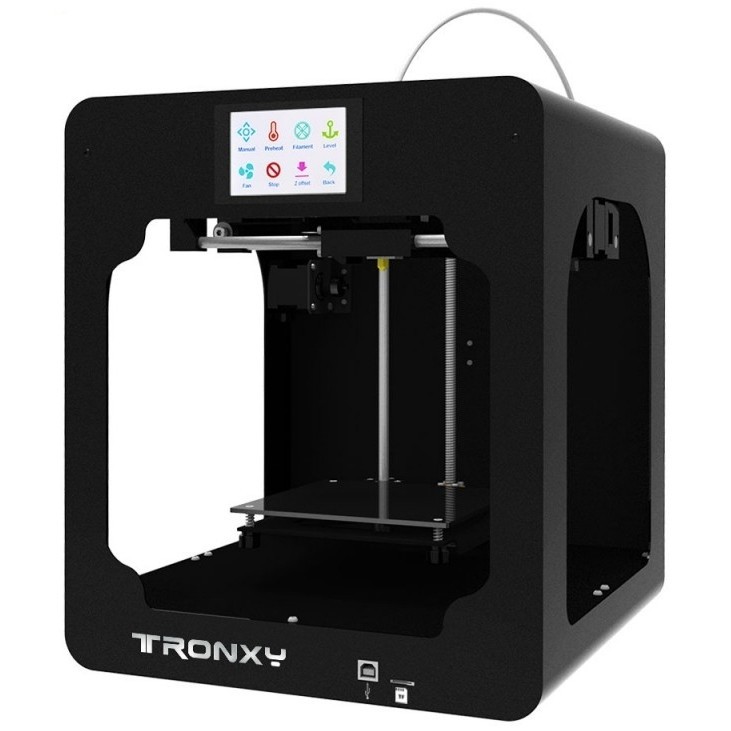 It has a proprietary Z nut coupler that reduces layer artifacts on 3D printed parts. The cable management on the Genius is also unique. Instead of the wires flying around, all cables are neatly tucked inside a flex cable for added safety and aesthetics.
It has a proprietary Z nut coupler that reduces layer artifacts on 3D printed parts. The cable management on the Genius is also unique. Instead of the wires flying around, all cables are neatly tucked inside a flex cable for added safety and aesthetics.
The sturdy aluminum body comes with a solid base that is easy to put together. You get a color TFT touchscreen for easy navigation through the various functions. Although the print quality is not amazing right out of the box, with some fine-tuning you will have a high-quality printing experience on a sub-$300 budget.
Standout Features
- Silent operation
- Neat cable management
- TFT touchscreen
Technical Details | |
|---|---|
| Price | $299 |
| Print volume | 220x220x250 mm |
| Bed leveling | Manual |
| Heated print bed | Yes |
| Supported slicers | Cura, Simplify 3D, PrusaSlicer, etc. |
| Filament diameter | 1.75 mm |
| Max hotend temperature | 240°C |
What We Like
- Easy assembly
- Synchronized Z-axis reduces layer artifacts
- Quick and reliable after-sales support
Could Be Better
- Needs some tweaking to get good quality prints
- Quality control needs improvement
Find Artillery Genius at
AmazonAliExpressGeekbuying
Monoprice Mini Delta V2
Best Delta printer
Check Price
Amazon
It can be tricky to find 3D printers under $300 that offer a high print speed and come with features like automatic leveling of its heated bed, and Wi-Fi connectivity. The Monoprice Mini Delta V2, however, is one of the few options that give you just that. The Mini Delta V2 is the successor to the original Mini Delta and one of the most versatile printers under $300 with a small form factor.
The Delta V2 comes with an updated color touchscreen, with a new look and a neatly designed user interface. This upgraded version offers automatic bed leveling to make your first layers stick perfectly to the build platform. On the connectivity side of things, it has a USB port, SD card slot, and inbuilt Wi-Fi to let you control your 3D printer remotely from your smartphone.
The self-diagnostic features are also unique to see in this category. The Delta mini runs an extruder heat check and checks the movement of all three axes when you turn it on. This helps prevent failed prints and wasting valuable filament.
A major downside of the Delta V2 is the small printing area and slightly reduced print quality because of the higher print speed. This is circumventable by turning the print speed down, but that does mean your 3D prints take longer.
Ultimately, the Delta V2 is an excellent beginner Delta 3D printer in a compact package at an attractive price.
Standout Features
- Auto bed leveling
- Touchscreen controls
- Wi-Fi connectivity
Technical Details | |
|---|---|
| Price | $179 |
| Print volume | ø110 x 120 mm |
| Bed leveling | Automatic |
| Heated print bed | Yes |
| Supported slicers | Cura, Simplify 3D, PrusaSlicer, etc. |
| Filament diameter | 1.75 mm |
| Max hotend temperature | 260°C |
What We Like
- High printing speeds
- Easily diagnoses issues
- Remote control and monitor prints
Could Be Better
- Small build volume
- Limited upgradability
Find Monoprice Mini Delta V2 at
Amazon
What to pay attention to when buying a 3D printer under $300?
When looking for a 3D printer under 300 dollars, there are a few things you should pay attention to. The first is the build volume. This is the maximum size of an object that the printer can create. You should also check the materials that the printer can use. Some printers can only use a single type of material, while others can use multiple types. You should also consider the print quality. Some printers produce higher quality prints than others.
Because 3D printers under $300 are guaranteed to cut corners in several areas, we will go into more detail on the things to look for in this section.
Pre-assembled vs a kit
To lower the 3D printer price, manufacturers often ship 3D printers as a DIY assembly kit. This has its own set of pros and cons. A pre-assembled kit is great for beginners and allows you to get started with 3D printing right away. You don’t need to figure out assembly manuals or decipher instructions to get that first 3D print going.
A DIY assembly kit, on the other hand, can be tedious to put together. If you’re a novice, it can take hours just to assemble the 3D printer. However, as a part of this assembly process, you get familiar with every component of the 3D printer and are better able to resolve any future issues.
So, if you want to get started right out of the box and don’t want to deal with the initial fine-tuning, a pre-assembled kit is best suited for you. But if you’re keen on understanding the little details of the 3D printer and love the DIY stuff, a 3D printer kit should be your go-to option.
Build quality
The build quality of any 3D printer plays a crucial role in the quality of the parts created on it. For example, the earlier generations of 3D printers, such as the Anet A8 or Tevo Tarantula, used acrylic materials in their frame design. This ultimately affected the quality of the printed parts and the reliability of the 3D printer itself.
For example, the earlier generations of 3D printers, such as the Anet A8 or Tevo Tarantula, used acrylic materials in their frame design. This ultimately affected the quality of the printed parts and the reliability of the 3D printer itself.
3D printer manufacturers have now figured out a way to introduce strong metal 3D printers while still keeping the costs low. For example, the Creality Ender 3 V2 series uses 20 x 20 aluminum extrusions in its frame design. Even the small Monoprice Mini Delta V2 uses a steel and aluminum body design.
Using aluminum and steel in 3D printer frames gives them extra rigidity. This makes the frames stiffer and limits flexing during printing. All of this directly translates to improved quality in prints and the long-term durability of the 3D printer.
Build volume
A 3D printer’s build volume is often a major consideration point while buying a 3D printer. The build volume dictates the size and the quantity of the objects that you can 3D print. Also, a bigger build volume means a bigger 3D printer footprint, thus occupying more space on your worktable or desk.
Also, a bigger build volume means a bigger 3D printer footprint, thus occupying more space on your worktable or desk.
We often assume that a large build volume is a good thing to have. Of course, if you’re going to print large objects, or run multiple 3D prints at once, a bigger build volume is your friend. But you need to consider that a bigger build volume also comes with more frame rigidity and inertia issues. You’ll need to print a little slower to get the best results.
Rather than going extremely small, or extremely big, a decent build volume such as the Ender 3 V2’s is perfectly suited for a lot of cases. You can easily carry the 3D printer around. It doesn’t take up much space and you can print at higher speeds without sacrificing quality.
Filament support
Some 3D printers under $300 are limited in terms of their filament support. This is because of the relatively low maximum extruder temperature and the lack of heated beds. Some 3D printers solely support only PLA, while others with a heated bed can also 3D print ABS and PETG.
Recommended:
PETG vs ABS: Which Filament Should You Use?
If you’re going to do just some basic level 3D printing, PLA filament might be enough for your needs. However, it’s always better to have that extra level of material compatibility with your 3D printers. ABS, PETG, and TPE/TPU are some materials that can be used in practical applications, such as gears, watch straps, bracelets, and snap-fit parts.
Recommended:
The 10 Best PLA Filaments for 3D Printing
If you take the Flashforge Finder, for example, it lacks a heated bed, and can only print with PLA. Whereas, the Anycubic Mega S or Ender 3 natively support a lot of materials and you can even upgrade them to be compatible with a lot of other materials as well.
Recommended:
The Best Filaments for the Ender 3
This brings us to the next point of aftermarket upgrades.
Aftermarket upgrades
To keep the costs down, manufacturers of 3D printers under 300 dollars can’t include every feature in their 3D printers.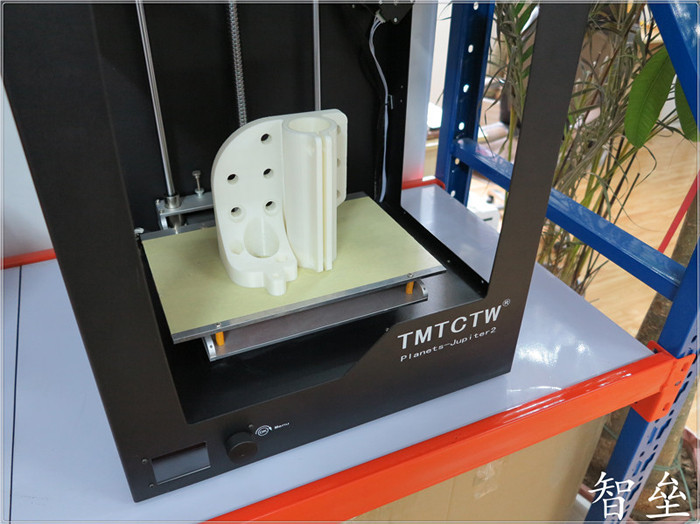 Some manufacturers just include the basic features, while others give the option to upgrade using third-party components.
Some manufacturers just include the basic features, while others give the option to upgrade using third-party components.
The flexibility to upgrade your 3D printers, later on, is a win-win situation for both the manufacturer and you as well. You don’t have to pay for the features which you might never use, and the manufacturer saves on a considerable amount of costs, thus keeping the prices down.
3D printers such as the Sovol SV01 and Artillery Genius have the option to add a probe for auto bed leveling. The Ender 3 and the Ender 3 V2 are also known for their wide range of aftermarket upgrades that you can use to add features.
Of course, these aftermarket upgrades are not always fully compatible with a specific 3D printer. If you run into any issues, the lack of direct support could be a potential problem. So, if you’re planning on upgrading your 3D printer, it’s always better to choose a 3D printer that has a proven track record and has good community support available.
Community support
It is easy to overlook the importance of community support in the 3D printing world. Good community support is even more crucial when you’re considering getting a 3D printer under $300.
Usually, manufacturers do not support these budget 3D printers very well. When it comes to 3D printers, there are simply too many details to cover. Even if some firms try to provide support for their machines, they may not be aware of everything there is to know about them. So, having a community of 3D printer users who have tried and tested everything saves you a lot of hassle.
You don’t have to fiddle around trying to figure out everything. You can glance up the issue and get your solution. Good community support also means that there will be a lot of community upgrades and forums for your particular 3D printer.
For example, most of the updates that you find in the Creality Ender V2 result from feedback from the community on the original Ender 3. So, it’s always beneficial to ensure that whichever 3D printer you plan to buy has good community support.
FAQ
Are 3D printers under $300 worth it?
Yes. 3D printing technology has come a long way since the 80s and even more so after the expiry of patents in 2009. Lots of manufacturers have developed good-quality 3D printers while still keeping costs down. This low price has also led to mass adoption of technology, which has led to an incentive to develop reliable 3D printers at a low cost.
Something to keep in mind, however, is that you won’t have everything with a 3D printer under 300. If you are looking to have automatic bed leveling, a resume printing function, removable build plate, high-quality titan extruder, large build volume, filament spool holder, and more in one single 3D printer, the sub-$300 price range is not going to offer you that.
It is, however, always possible to upgrade your 3D printer later. There is a plethora of Ender 3 upgrades available, such as the BLTouch leveling sensor that removes the hassle of manually leveling the print bed.
Similarly, you aren’t going to find an enclosed 3D printer at this price point. The costs of a closed frame are simply too high to fit into this budget category.
The costs of a closed frame are simply too high to fit into this budget category.
If you are interested in printers that are loaded with features, a 3D printer under $500 or a 3D printer under $1000 will better suit your needs.
How long will a $300 3D printer last?
There’s no definitive answer to this question. If you carry out regular maintenance of your 3D printer, there’s no reason for it to not last at least five to ten or even more years. In terms of upgradability too, if your 3D printer supports external upgrades, you can upgrade your 3D printer to keep with the latest trends.
Can you use a $300 3D printer for professional purposes?
Yes, and no. If you’re looking for a purely professional use case scenario, 3D printers under $300 might simply not be suitable for your workflow. They’re designed for a wide populace and will lack the necessary features for a professional setting.
If you are a small business owner looking for small productions and you don’t mind fiddling around with settings, a $300 3D printer will suit you just fine until you have the need to upgrade to something better.
Conclusion
Considering everything that we’ve discussed so far, it’s easy to figure out the best 3D printer under $300. The Anycubic Kobra is the easiest to use and has the most advanced features printers at the $300 price point and is a clear winner. The Ender 3 and the Anycubic Photon Mono are the runner-ups as budget and resin picks.
Recommended:
Resin vs Filament 3D Printers: What’s the Difference?
The Anycubic Kobra checks almost everything that you’d expect from a 3D printer in this category. It’s easy to assemble, supports a lot of filaments, has a good build quality and you can even upgrade it with aftermarket components. These undoubtedly make it the best choice under $300.
Let us know your thoughts on this list. If you feel we’ve missed out on anything, let us know in the comments below.
top 10 rating according to KP
A 3D printer opens up incredible opportunities for a person. The first prototype of such a device was born back in 1984.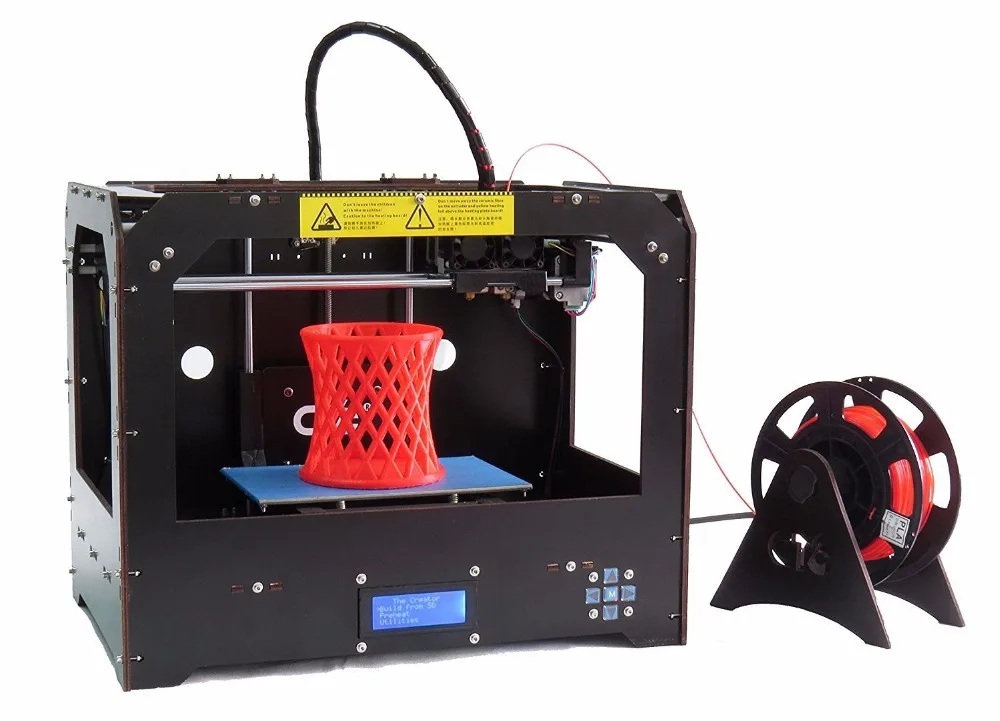 The idea of the invention belongs to the American Charles Hull, he received a patent for it only two years after development. The printer was a rather massive industrial installation and, despite many inaccuracies and shortcomings in operation, the technology was used.
The idea of the invention belongs to the American Charles Hull, he received a patent for it only two years after development. The printer was a rather massive industrial installation and, despite many inaccuracies and shortcomings in operation, the technology was used.
Hal co-founded 3dsystems, a leader in industrial 3D printers. However, this material is not dedicated to these large machines. 3D printing is becoming more and more part of everyday life. Thus, the technology is used to create unique toys, various models, figurines, packaging, clothes, shoes and jewelry. For these purposes, it is not at all necessary to purchase a large-sized printer. You can get by with a small device. It has a compact size, and its technology is completely identical to the industrial one. Heated plastic is fed through the nozzle (spout) of the device, which is laid out on the surface in accordance with the drawing specified in the program. And if earlier such a device was a luxury that only a few can afford, today a 3D printer is available to everyone.
Top 10 rating according to KP
1. Creality3D Ender 3
Creality3D Ender 3. Photo: market-yandex.ruOur rating opens with a model from the world's largest manufacturer of 3D printers. The Ender 3 features an elegant and thoughtful design, excellent print quality and a wide build area. Manufacturers have provided a good arrangement of wires that do not get confused during operation. The small control unit of the device is located to the right of the work surface. The gadget prints perfectly with various types of plastic. In particular, we are talking about varieties of ABS, PLA, TPU and PETG. The scope of this printer is quite wide. It can be used to produce minifigures, do artistic modeling, and make small prototypes of parts and functional elements.
Main characteristics
| Print technology | fdm/fff/pjp |
| Field | PLA, Wood |
| Workspace width | 220 mm |
| Workspace height | 250 mm |
| Features | Heated table, display, active cooling, Change of nozzles |
| Connection | Wi-Fi, USB |
| Extruders | |
| Compatibility with operations /Unix | |
| 3D model file format | STL, OBJ |
Pros and cons
Webcam and Wi-Fi receiver allows you to monitor work, devices from anywhere in the world in the setup, the presence of a filament sensor
Despite the rather wide functionality, this model is hardly suitable for an experienced printer or a small production due to the small area of the working space, high price
3.
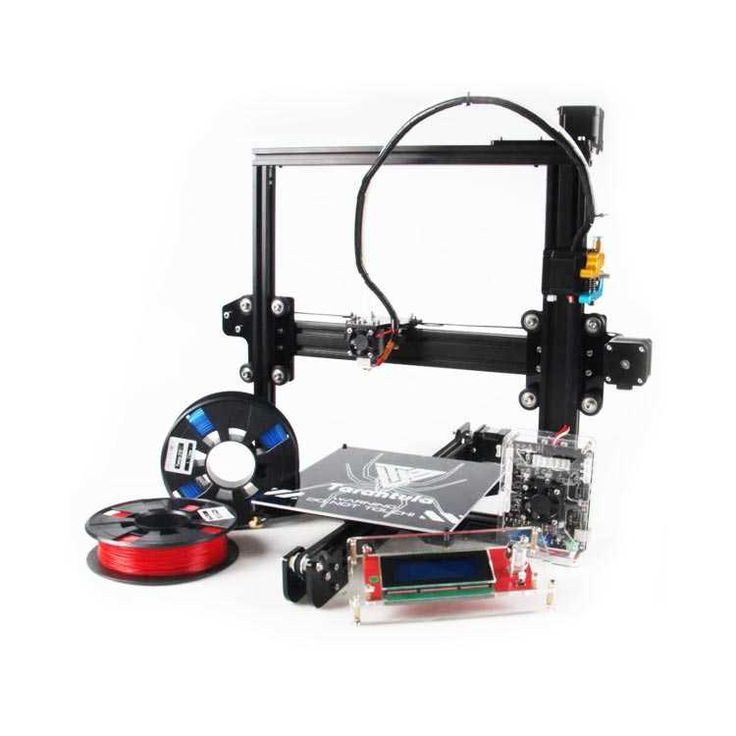 FlyingBear Ghost 5 FlyingBear Ghost 5. Photo: market-yandex.ru from FlyingBear is ideal for semi-professional use. Uniform supply of filament (plastic) provides good opportunities for creating three-dimensional figures with a fairly high resolution. High productivity is achieved thanks to the transparent Dual Drive extruder with BMG double drive. The gadget has a body closed on three sides. Its walls are made of heat-resistant non-toxic ABS plastic. This protection prevents the accumulation of dust on the working parts of the device, which greatly facilitates the maintenance of the printer. The device is controlled using a 3.5-inch color TFT display.
FlyingBear Ghost 5 FlyingBear Ghost 5. Photo: market-yandex.ru from FlyingBear is ideal for semi-professional use. Uniform supply of filament (plastic) provides good opportunities for creating three-dimensional figures with a fairly high resolution. High productivity is achieved thanks to the transparent Dual Drive extruder with BMG double drive. The gadget has a body closed on three sides. Its walls are made of heat-resistant non-toxic ABS plastic. This protection prevents the accumulation of dust on the working parts of the device, which greatly facilitates the maintenance of the printer. The device is controlled using a 3.5-inch color TFT display. Main characteristics
| Print technology | fdm/fff/pjp | |||
| Field | for house/diy, initial level | |||
| Open Camera | Open Camera | Open Cam | ABS, PLA, Wood, HIPS | |
| Workspace width | 255 mm | |||
| Workspace height | 210 mm | |||
| Working space | 210 mm | |||
| Features | Heated table, display, active cooling, nozzle adjustment, temperature control | |||
| Connection | Wi-Fi, SD | , SD , SD 9001|||
| Print speed (extruder speed) | 150mm/s | |||
| Number of extruders | 1 | |||
| Printing accuracy | X, Y 0. 01 mm 01 mm | |||
| Positioning accuracy | Z 0.002 mm |
Pros and cons
Short power cord, inaccuracies in the Russian-language menu, weak airflow system.
4. Anet N4
Anet N4. Photo: market-yandex.ruThe budget model from the Chinese manufacturer Anet N4 is equipped with all the necessary functions for a small domestic production. The base of the device is made of cast aluminum alloy. The weight of the gadget does not exceed 9kg. A transparent tinted hood protects the work surface from external sources of ultraviolet radiation. It can be removed to remove the finished product and clean the printer. Also, manufacturers have provided a removable resin bath and a working platform, which greatly facilitates the use of the device.
Key Features
| Print Technology | LCD | |
| Application | Home/DIY Professional | 30 mm/h |
Pros and cons
Ability to use photopolymer resins from any manufacturer, high polymer curing speed
Small work surface, slightly inferior to competitors in some parameters
Photon Scu0bic0 Anycu0bic08 5.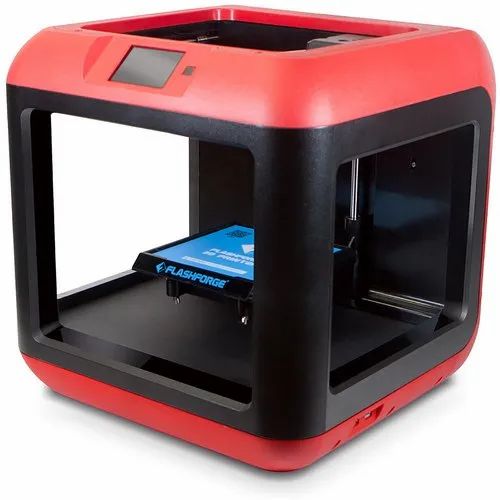 S. Photo: market-yandex.ru
S. Photo: market-yandex.ru In the middle of our rating is the Anycubic Photon S model. It is equipped with an advanced optical system and a large working camera. The device has a matrix light source that provides a uniform luminous flux over the entire plane of the desktop. This allows a very high curing speed of the layers to be achieved. In addition, the printer has an original function that allows you to simultaneously print eight identical models. According to the developers, the target audience for this device are orthodontists and jewelers. Most parts of the device are made of plastic. This factor significantly reduces the weight of the device and makes it convenient to transport.
Plus and minuses
High printing quality
Small worktop
6. ELEGOO Mars Pro
ELEGOO Mars Pro. Photo: market-yandex.ru
Photo: market-yandex.ru This model is significantly different from its predecessor Elegoo Mars. Thanks to the advanced Z-axis mechanics and directional UV light from the diode array, it is suitable not only for hobbies, but also for fields of activity such as dentistry and jewelry. In addition, the developers moved the USB connector to the front of the device. Now there is no need to constantly rotate the gadget in the process. The weight of the device is only 7.5 kg, which makes it very convenient for transportation. A translucent plastic cover will reliably protect against extraneous radiation and will allow you to monitor the production process.
The main characteristics
| Print technology | LCD |
| Field | for the home/diy, for medicine |
| Print speed: (layer build-up) | 22.5 mm/h |
| Print precision | X, Y 0.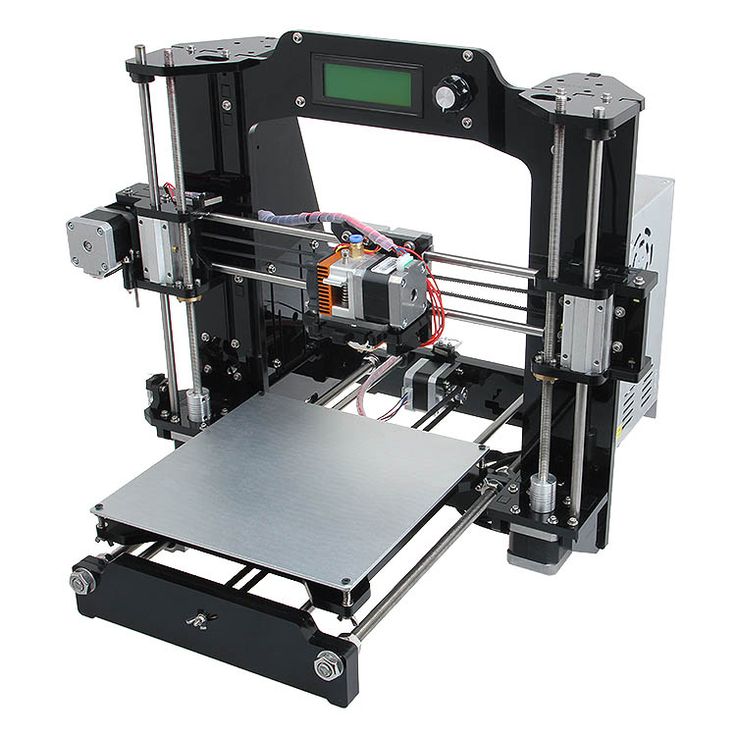 047 mm 047 mm |
| Positioning accuracy | Z 0.125 mm |
| The wavelength of light source | 405 Nm |
PLASS AND MINCOUS COUREDENDENT, LIGHT price, good UF-Room Light 9,0008 7. Two Trees Bluer
Two Trees Bluer. Photo: market-yandex.ruThis is one of the most popular home models of 3D printers. It is ideal for getting acquainted with technology, various experiments, training and prototyping. Distinctive features of Two Trees Bluer are: "quiet" drivers, which are the engine of the device, a heated table, two-way airflow and a thread break sensor. The mechanics of the printer is quite simple, and at the same time very effective. The open type case will be very convenient when cleaning the work surface. The firmware of the device provides the functions of auto-calibration and automatic resumption of printing in case the power was accidentally turned off.
Pros and cons
Low price, easy and convenient to use
Lack of protection for the work surface, poor quality of spare parts
8.
 Wanhao Duplicator i3 Mini Duplicator Mini i3. Photo: market-yandex.ru
Wanhao Duplicator i3 Mini Duplicator Mini i3. Photo: market-yandex.ru Miniature 3D printer does not look like other devices. However, this feature does not affect its technical characteristics. The plastic spool is located on the right side of the bracket. Wanhao branded coating is pasted over the table. There is no platform heating, so it is recommended to use PLA plastic for printing. The manufacturer clearly states in the manual that the printer is designed to work only with PLA material and nothing else. The body of the gadget is made of sheet steel. The memory card slot and all printer control elements - a monochrome liquid crystal display, a universal knob-button and a Reset micro-button - are placed on the front panel of the printer.
The main characteristics
| Print technology | FDM/FFF/PJP | ||||||||||||||||||||||||||||||||||||||||||||||||||||||||||||
| Field | Educational, for House/DIY, for medicine | ||||||||||||||||||||||||||||||||||||||||||||||||||||||||||||
| Openly Camera | Open | PLA | |||||||||||||||||||||||||||||||||||||||||||||||||||||||||||
| Working space width | 120 mm | ||||||||||||||||||||||||||||||||||||||||||||||||||||||||||||
| Working space height | 100 mm | ||||||||||||||||||||||||||||||||||||||||||||||||||||||||||||
| The depth of the workspace | 135 mm | ||||||||||||||||||||||||||||||||||||||||||||||||||||||||||||
| Features | displays, active cooling, speed control, temperature control | ||||||||||||||||||||||||||||||||||||||||||||||||||||||||||||
| USB, SD card | ) | 70 mm/s | |||||||||||||||||||||||||||||||||||||||||||||||||||||||||||
| Number of extruders | 1 | ||||||||||||||||||||||||||||||||||||||||||||||||||||||||||||
| Printing precision | X, Y 0. 012 mm 012 mm |
| Print technology | FDM/FFF/PJP |
| Scope | Educational, for the house/DIY, Industrial, Professional Material |
| ABS, Flex, Nylon, PLA, PETG, SBS, CopperFILL, DuraForm TPU | |
| Workspace width | 220 mm |
| The height of the workspace | 250 mm |
| Dent of the workspace | 220 mm |
| Features | Heated table, Active streaming, Control adjustment, Tempension |
| USB, micro-SD | |
| Print speed (extruder speed) | 150 mm/s, |
| Number of extruders | 1 |
Pros and cons
Spacious work surface, robust housing
Little functionality for a rather high price, lack of work surface protection, few functions on the control screen.
10. Tianfour Sparkmaker
Tianfour Sparkmaker. Photo: market-yandex.ruThis model is ideal for beginners, as it does not require additional settings at all before starting work. Externally, the printer has the shape of a cylinder with a height of 27.5 cm and a diameter of 17 cm. The realistic contours and smooth curves of the figures are ensured by LCD technology. The printer works with any photopolymer resins for 3D printing with a flash length of 405nm.
How to choose a 3D printer
Choosing a 3D printer is not such a difficult task as it might seem at first glance. Despite the relentless interest in 3D printing and the incredible number of devices on the market, the basic requirements for models remain unchanged. Komsomolskaya Pravda turned to Svyatoslav Vulf, a blogger and host of a YouTube channel about modern technologies and experiments, for help in this matter. He regularly monitors new products on the 3D technology market and tests them at home.
Product size
Initially, you should decide what size of products you expect to receive in the end. The required area of the working surface depends on this. Note that the price of the device also depends on the size of the latter. For work at home, there will be enough indicators: 200 × 250 × 200 (WxHxD).
Technology
Today, there are several technologies for printing on a 3D printer. They differ significantly from each other. Let's consider some of them.
SLA-technology — works on the basis of a liquid photopolymer, which under the influence of laser light changes its physical properties and hardens. It allows you to create figurines with the highest precision of microforms.
DLP technology is an alternative SLA method. However, instead of laser systems, LED projectors are used here, which significantly reduce the cost of 3D printers. When using this technology, the future prototype is formed layer by layer.
The FDM method is ideal when prototypes are required that will be actively used and not just sitting on a shelf. Here, high-strength industrial plastics will be used for production. Please note that there are other technologies, but they are very similar to the above.
Material
Before buying a printer, you should also pay attention to what materials it works with, as they have significant differences from each other. For example, ABS can take many different polymeric forms. This is a very durable plastic. It is easily sanded and processed. PLA plastic is considered more environmentally friendly. It is made from agricultural products - corn, potatoes, beets and others. In its original form, it is transparent and can be colored. PLA is just as strong but tougher than ABS. The ductility and heat resistance of SBS make it the material of choice in engineering and mechanical applications.
Noise level and drivers
An important factor when choosing a 3D printer are drivers - device engines (not to be confused with software).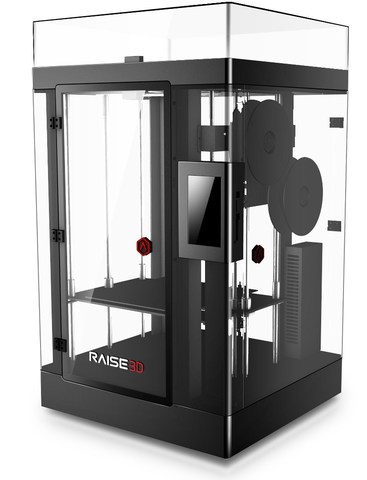 They affect the overall noise level of the device. For example, if you buy a printer with cheap A4988, then even neighbors will hear its work. In this case, you should pay a little more and purchase a gadget with more expensive drivers.
They affect the overall noise level of the device. For example, if you buy a printer with cheap A4988, then even neighbors will hear its work. In this case, you should pay a little more and purchase a gadget with more expensive drivers.
Self-assembly
Some manufacturers prepare the model completely before sale. The buyer can only get the printer out of the box and connect the power. However, there are some models that require self-assembly. Be sure to consider this factor before purchasing. If you are purchasing such a device for the first time, then it will not be easy for you to assemble it.
Top 20 Inexpensive 3D Printers ($199 to $1000)
3DPrintStory Reviews Top 20 Inexpensive 3D Printers ($199 to $1000)
Just 10 years ago, a 3D printer cost over $100,000. Today, you can easily find a cheap 3D printer for under $200. This is amazing.
Today, you can easily find a cheap 3D printer for under $200. This is amazing.
Naturally, the lower the price, the more restrictions. Some of the printers on our list will not have a heated bed and the workspace will be small. Naturally, the quality of most of the models presented below cannot compete with more expensive counterparts.
But with a little patience and diligence, it is quite possible to achieve high-quality 3D printing on a printer that costs half the price of a flagship smartphone. And it's really cool!
Important note : All 3D printers in this top are supplied assembled by the manufacturer. If you have free time and want to spend less money, you can buy DIY kits and assemble the 3D printer yourself according to the instructions.
List of the best cheap 3D printers in the price range from $ 200 to $ 1000
| 3D Printer | Material | 0018 | 459 | |
|---|---|---|---|---|
| Flashforge Finder | PLA | 90 X 140 x 140842 499 | XYZPRINTING DAM. 1.0 Pro 1.0 Pro | PLA | 150 x 150 x 150 | 499 |
| XYZprinting da Vinci Jr. Mix 2.0 | PLA | 150 x 150 x 150 | 599 | |
| Printrbot Simple | PLA | 150 x 150 x 150 | 599 | |
| UP mini 2 | PLA, ABS | 120 x 120 x 120 | 599 | |
| Monoprice Maker Select Ultimate | PLA, ABS, exotic | 200 X 2008 | 699 | |
| ROBO C2 | PLA | 9ATH0021 |||
| Dremel Idea Builder | PLA | 230 x 150 x 140 | 899 | |
| Printrbot Simple Pro | PLA | 200 x 150 x 200 | 999 | |
| Prusa i3 MK2 | PLA, ABS, exotic | 250 x 210 x 200842 | |
In the article we consider unfinished, but high -quality 3D prints on ABA etc.

If you want to buy them, even if you live in large cities such as Kyiv, Moscow, St. Petersburg, Minsk, it may turn out that these models will not be in the online stores of your city, or they may be with a decent mark-up relative to the cost that indicated in the article.
Since most of them are European / American, it is possible that they will not be in stores at all.
Therefore, before making a choice, I recommend looking directly at eBay, Amazon, Aliexpress, etc. - many sellers on these planforms deliver to the CIS countries within 1-4 weeks on average.
It is especially worth monitoring these platforms during the discount period - Black Friday or Chinese New Year (Aliexpress or Gearbest) - prices on such days can be 2 or more times lower than usual and it is worth waiting a few weeks.
Monoprice MP Select Mini ($199)
Probably the best 3D printer on our list. Why? Because the Monoprice MP Select Mini is an impressive development with a thoughtful, compact design at a very low price. This model has a quick-change steel material feed wheel, a cooler for cooling the nozzle, a color LCD screen, a heated table, plus the ability to transfer models for 3D printing via microSD or USB.
This model has a quick-change steel material feed wheel, a cooler for cooling the nozzle, a color LCD screen, a heated table, plus the ability to transfer models for 3D printing via microSD or USB.
The heated bed and wide temperature range of the extruder are especially pleasing, because for such a small price you get the opportunity to print in different materials: from ABS B to PLA or exotic materials like conductive PLA plastic, wood, metal-based composites and PVA.
For those who are worried about the lack of a guarantee - for such a price it is possible without it. This model is upgradeable. For example, you can install a new nozzle, change the table and add WiFi connectivity.
Small working space - 120 x 120 x 120 mm. Over time, this will definitely not be enough for you.
Specifications of cheap 3D printer Monoprice MP Select Mini
- Printer type: FDM;
- 3D printing materials: ABS, PLA, exotic;
- Working space: 120 x 120 x 120 mm;
- Minimum layer height: 100 microns;
- Number of extruders: 1;
- 3D printing speed: 55 mm/s;
- Compatible with 3rd party materials: yes;
- Heated table: yes;
- Nozzle diameter: 1.
 75 mm;
75 mm; - 3D printer control panel: yes;
- Connection: SD card, USB.
Back to the list of 3D printers
M3D Micro Retail ($249)
The M3D Micro 3D printer hit the market thanks to Kickstarter. This model was presented with an incredible price of $349.
The working space of the M3D Micro is 109 x 113 x 166 mm. There are several body color options. The company has implemented "Micro Motion Technology" - a set of innovative solutions - thanks to which you get excellent quality 3D printing at a small price.
Today, this inexpensive 3D printer already costs even less than the price announced on Kickstarter. You can buy it for $249 with a 12 month warranty. By the way, it is already possible to pre-order the next "pro" version.
Specifications of cheap 3D printer M3D Micro Retail
- Printer type: FDM;
- 3D printing materials: PLA;
- Working space: 116 x 109 x 113 mm;
- Minimum layer height: 50 microns;
- Maximum layer height: 350 microns;
- Number of extruders: 1;
- XY accuracy: 15 microns;
- Open Source: no;
- 3D printing speed: 55 mm/s;
- Compatible with 3rd party materials: yes;
- Heated table: yes;
- Nozzle diameter: 1.
 75 mm;
75 mm; - Control panel on 3D printer: no;
- Connection: USB.
Back to 3D printer list
XYZprinting da Vinci Mini ($289)
Da Vinci Mini is a successful attempt to make a 3D printer user-friendly. This model has only one button and 5 multi-colored indicators that reflect the current status of 3D printing. In addition, this affordable 3D printer is WiFi capable so you can control it over a network in your home, office or lab.
Unfortunately, you can only use the manufacturer's own 3D materials. On average, they cost 20% more than usual. However, the company also argues that the materials used (PLA) will be 100% non-toxic.
Specifications of cheap 3D printer XYZprinting da Vinci Mini
- Printer type: FDM;
- 3D printing materials: PLA;
- Working space: 150 x 150 x 150 mm;
- Minimum layer height: 100 microns;
- Number of extruders: 1;
- Open Source: no;
- Compatible with 3rd party materials: no;
- Heated table: no;
- Nozzle diameter: 1.
 75 mm;
75 mm; - 3D printer control panel: yes;
- Connection: USB, WiFi.
Back to 3D printer list
Monoprice Maker Select V2($299)
The next cheap 3D printer with a good reputation is the Monoprice Maker Select V2.
This model is an analogue of the Wanhao Duplicator i3, which, in turn, borrowed the design from the Prusa i3. But this does not affect the quality, as the Monoprice Maker Select V2 is easy to use and gives excellent 3D printing results.
Monoprice Maker Select V2 design feature is that the power supply and control panel are placed outside the 3D printer. The working space of this model is 200 x 200 x 180 mm. And this is really a good indicator for the money.
Specifications of cheap 3D printer Monoprice Maker Select V2
- Printer type: FDM;
- 3D printing materials: ABS, PLA, exotic;
- Working space: 200 x 200 x 180 mm;
- Minimum layer height: 100 microns;
- Number of extruders: 1;
- Open Source: software;
- Compatible with 3rd party materials: yes;
- Heated table: yes;
- Nozzle diameter: 1.
 75 mm;
75 mm; - 3D printer control panel: yes;
- Connection: USB, SD card.
Back to the list of 3D printers
New Matter MOD-t ($299)
New Matter is a young startup that offers a 3D printer MOD-t - An interesting design with a minimalistic design. This cheap 3D printer is WiFi enabled so you can manage print settings and print from your computer, tablet or smartphone. The working space is 150 x 150 x 125 mm. Thanks to the case, the noise during its operation is reduced. But the most interesting and attractive thing about MOD-t is the price. Only $299. In general, this is an interesting, high-quality model.
Specifications of cheap 3D printer New Matter MOD-t
- Printer type: FDM;
- 3D printing materials: PLA;
- Working space: 150 x 100 x 125 mm;
- Minimum layer height: 100 microns;
- Number of extruders: 1;
- Open Source: no;
- Compatible with 3rd party materials: yes;
- Heated table: no;
- Nozzle diameter: 1.
 75 mm;
75 mm; - Control panel on 3D printer: no;
- Connection: USB, WiFi.
Back to the list of 3D printers
Printrbot Play ($399)
The Printbot Play is a very popular budget 3D printer that is often used in education. This inexpensive, reliable model, which is almost entirely made of metal.
The working space is 100 x 100 x 130 mm. Printbot Play has an extruder manufactured by the company itself - Alu Extruder v2. The body is made of powder coated steel and aluminium. SD slot provided.
You can upgrade the basic design of the Printrbot Play with a heated stand or increase the Y-axis stroke.

Back to 3D printer list
Wanhao Duplicator i3 Plus ($459)
The Wanhao Duplicator i3 Plus is an upgraded version of the popular Wanhao Duplicator i3 (which in turn is based on the Prusa i3).
The main features of this cheap 3D printer are a large working space of 200 x 200 x 180 mm, a steel frame, electronics integrated into the design itself (previously it was taken out separately), a slot for a full-size SD card and a touchscreen display for control.
Wanhao Duplicator i3 Plus Cheap 3D Printer Specifications
- Printer type: FDM;
- 3D printing materials: ABS, PLA, exotic;
- Working space: 200 x 200 x 180 mm;
- Minimum layer height: 100 microns;
- Number of extruders: 1;
- Open Source: design and software;
- Compatible with 3rd party materials: yes;
- Heated table: yes;
- Nozzle diameter: 1.75 mm;
- 3D printer control panel: yes;
- Connection: USB, SD card.
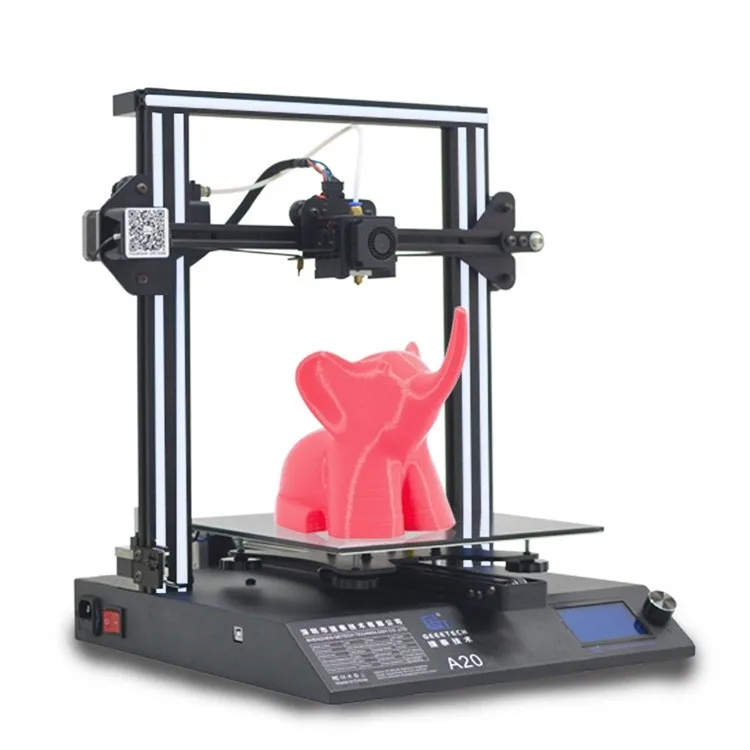
Back to the list of 3D printers
Flashforge Finder ($499)
FlashForge Finder is one of the newest 3D printers on our list. This affordable 3D printer offers an average working space of 140 x 140 x 140mm.
This Finder features a transparent sidewall design so you can view the 3D printing process from any angle. A color display is installed, it is possible to transfer data via WiFi network. The printer comes with some supplies and a USB flash drive, so you can start 3D printing almost immediately.
Specifications of cheap 3D printer FlashForge Finder
- Printer type: FDM;
- 3D printing materials: PLA;
- Working space: 140 x 140 x 140 mm;
- Minimum layer height: 100 microns;
- Number of extruders: 1;
- XY accuracy: 11 microns;
- Open Source: no;
- Compatible with 3rd party materials: yes;
- Heated table: no;
- Nozzle diameter: 1.75 mm;
- 3D printer control panel: yes;
- Connection: USB, WiFi.

Back to 3D printer list
XYZprinting da Vinci Jr. 1.0 Pro ($499)
What's so special about the da Vinci Jr. 1.0 pro? This is a new model from XYZPrinting, which includes many advanced features, such as support for printing materials from other manufacturers and increased speed of 3D printing.
Also features an auto-calibration mechanism, a closed chamber with a unique cooling system, and a 0.3mm nozzle option for high-quality printing of fine model details. All in all, this is a great 3D printer with a lot of useful features and at a low price.
Specifications for cheap 3D printer da Vinci Jr. 1.0 Pro
- Printer type: FDM;
- 3D printing materials: PLA;
- Working space: 150 x 150 x 150 mm;
- Minimum layer height: 100 microns;
- Number of extruders: 1;
- Open Source: no;
- Compatible with 3rd party materials: yes;
- Heated table: no;
- Nozzle diameter: 1.
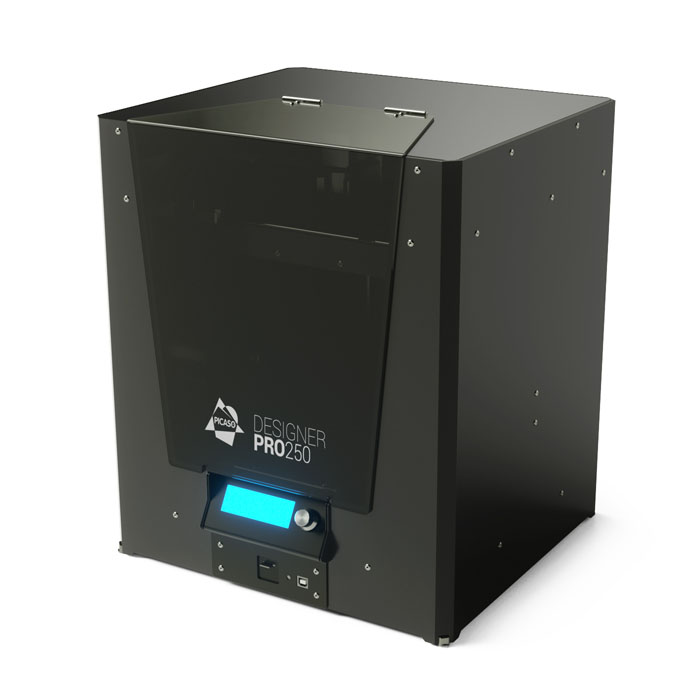 75 mm;
75 mm; - 3D printer control panel: yes;
- Connection: USB, SD card.
Back to 3D printer list
XYZprinting da Vinci Jr. Mix 2.0 ($599)
XYZprinting provides a wide range of low cost 3D printers. And paying attention to each model is quite difficult, although many of them are very interesting.
XYZprinting da Vinci Jr. Mix 2.0 stands out because it can print with two different materials and mix them to create multi-colored models. This dual-color 3D printing technology is rare in this price range ($500 to $1,000), so if you're interested in experimenting with multicolor printing, XYZprinting da Vinci Jr. Mix 2.0 is a great choice.
However, there is a drawback. This 3D printer is not compatible with materials from other manufacturers, so you will have to buy special materials from XYZprinting (as we mentioned above, they cost 20% more, but are not toxic).
Specifications of cheap 3D printer XYZprinting da Vinci Jr.
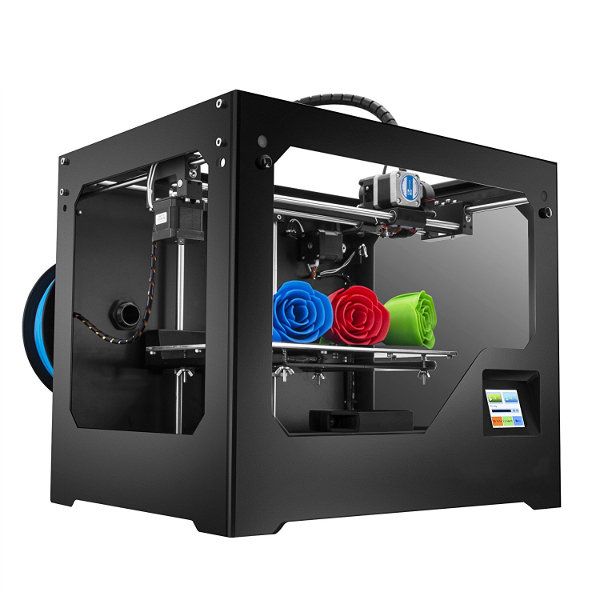 Mix 2.0
Mix 2.0 - Printer type: FDM;
- 3D printing materials: PLA;
- Working space: 150 x 150 x 150 mm;
- Minimum layer height: 200 microns;
- Number of extruders: 1;
- Open Source: no;
- Compatible with 3rd party materials: no;
- Heated table: no;
- Nozzle diameter: 1.75 mm;
- 3D printer control panel: yes;
- Connection: USB, SD card, WiFi.
Back to the list of 3D printers
Printrbot Simple ($599)
Printrbot Simple is the flagship of the Printbot empire. This model has a great open design with a solid aluminum frame and a working space of 150 x 150 x 150mm. This inexpensive 3D printer comes fully assembled at a very good price. As you need and want to experiment, you can add a heated table and expand the workspace in the horizontal plane.
Specifications of cheap 3D printer Printrbot Simple
- Printer type: FDM;
- 3D printing materials: PLA;
- Working space: 150 x 150 x 150 mm;
- Minimum layer height: 100 microns;
- Number of extruders: 1;
- 3D printing speed: 80 mm/s;
- Open Source: design and software;
- Compatible with 3rd party materials: yes;
- Heated table: optional;
- Nozzle diameter: 1.
 75 mm;
75 mm; - Control panel on 3D printer: no;
- Connection: USB.
Back to the list of 3D printers
UP mini 2 ($599)
The UP mini 2 is a low cost 3D printer that packs in impressive design and functionality. For starters, it has a touch screen panel and the ability to connect via WiFi.
But the most interesting is further. Implemented power failure protection system. 3D printing will continue after the emergency stop. Built-in HEPA air filtration system. Automatic detection of the height of the extruder nozzle. A separate, closed container for the material, thanks to which it does not deteriorate under the influence of moisture from the environment.
Great 3D printer for a small price. The only thing that upsets me a little is the small working space - 120 x 120 x 120 mm.
Specifications of cheap 3D printer UP mini 2
- Printer type: FDM;
- 3D printing materials: PLA, ABS;
- Working space: 120 x 120 x 120 mm;
- Minimum layer height: 150 microns;
- Maximum layer height: 350 microns;
- Number of extruders: 1;
- Open Source: no;
- Compatible with 3rd party materials: yes;
- Heated table: yes;
- Nozzle diameter: 1.
 75 mm;
75 mm; - 3D printer control panel: yes;
- Connection: USB, WiFi.
Back to the list of 3D printers
Monoprice Maker Select Ultimate ($699)
The Monoprice Maker Select Ultimate is an extraordinary beast that combines elements from two leaders in the world of 3D printing - Zortax and Ultimaker. The Monoprice Maker has an aluminum perforated printing table, which was offered in the Zortax M200 (thanks to this table, the grip of the base of the model with the table is much better), and the software part is almost identical to Ultimaker 2 (very user-friendly interface and functionality).
This model uses a "Bowden extruder", that is, the feed blocks and nozzle are separated, unlike direct feed. This improves reliability and reduces the likelihood of 3D printing errors (although, most likely, it was necessary to sacrifice printing speed, as the weight of the printing unit increases). Given the cost, this is a good model, the analogues of which are much more expensive.
Specifications of cheap 3D printer UP mini 2
- Printer type: FDM;
- 3D printing materials: PLA, ABS, exotic;
- Working space: 200 x 200 x 175 mm;
- Minimum layer height: 20 microns;
- Number of extruders: 1;
- Open Source: no;
- Compatible with 3rd party materials: yes;
- Heated table: yes;
- Nozzle diameter: 1.75 mm;
- 3D printer control panel: yes;
- Connection: USB, SD card.
Back to the list of 3D printers
Robo C2 ($799)
The Robo C2 is a small 3D printer with tons of connectivity options. Using a specialized application, you can monitor the status of 3D printing from your smartphone or tablet. It can be connected to a Chromebook. Thanks to the built-in slicing program, you do not need to install additional printing software.
Probably the most impressive is the integration with Amazon Alexa. Users can stop, cancel and check the status of 3D printing in real time using voice commands.
What does this inexpensive 3D printer offer? Working space 127 x 127 x 150 mm. The 3D printing speed is 300 mm/s and the resolution is 20 microns. There is a built-in 3.5'' color touch screen, a system for monitoring the amount of remaining material for printing, automatic calibration and a removable self-aligning print platform. The only drawback is that the table is not heated, so you have to use PLA plastic.
Specifications of cheap 3D printer Robo C2
- Printer type: FDM;
- 3D printing materials: PLA;
- Working space: 127 x 127 x 150 mm;
- Minimum layer height: 20 microns;
- Number of extruders: 1;
- Open Source: software;
- Compatible with 3rd party materials: yes;
- Heated table: no;
- Nozzle diameter: 1.75 mm;
- 3D printer control panel: yes;
- Connection: USB, WiFi.
Back to the list of 3D printers
Wanhao Duplicator 4S ($829)
The Duplicator 4S has 2 extruders. It's essentially a copy of the MakerBot Replicator. Behind the steel body is the MK10 material feed mechanism, which is currently the easiest to use and most sought after in the market for 3D printer components.
It's essentially a copy of the MakerBot Replicator. Behind the steel body is the MK10 material feed mechanism, which is currently the easiest to use and most sought after in the market for 3D printer components.
One of the features of this model is a high-precision material feed wheel, which ensures the same filament feed speed. The Duplicator 4S is equipped with a 0.4mm precision nozzle.
Specifications of cheap 3D printer Duplicator 4S
- Printer type: FDM;
- 3D printing materials: ABS, PLA, exotic;
- Working space: 225 x 145 x 150 mm;
- Minimum layer height: 100 microns;
- Maximum layer height: 500 microns;
- Number of extruders: 2;
- XY accuracy: 11 microns;
- 3D printing speed: 40 mm/s;
- Open Source: software;
- Compatible with materials from other manufacturers: yes;
- Heated table: yes;
- Nozzle diameter: 0.4 mm;
- 3D printer control panel: yes;
- Connection: USB, SD card.

Back to the list of 3D printers
Polar 3D Printer ($899)
Polar 3D belongs to a separate category of 3D printers in this top, since this model implements the polar coordinate system. This causes the table to rotate and the print head to move up, down, right, and left.
Thanks to the polar coordinate system, this 3D printer is powered by two stepper motors, so it consumes less power. In addition, it turned out to realize a larger size of the working area: 203 (table diameter) x 152 (Z coordinate) mm.
Rated $899, but there are special discounts for educational institutions. The discounted price is only $599.
Specifications of cheap 3D printer Polar 3D
- Printer type: FDM;
- Materials for 3D printing: PLA;
- Working space: 203 (table diameter) x 152 (Z-coordinate) mm;
- Minimum layer height: 50 microns;
- Maximum layer height: 400 microns;
- Number of extruders: 1;
- 3D printing speed: 40 mm/s;
- Open Source: no;
- Compatible with 3rd party materials: yes;
- Heated table: no;
- Nozzle diameter: 1.
 75 mm;
75 mm; - Control panel on 3D printer: no;
- Connection: USB, WiFi, SD card.
Back to 3D printer list
FlashForge Creator Pro ($899)
You've probably heard of this 3D printer. FlashForge Creator Pro is very similar to Makerbot Replicator 2X. This inexpensive 3D printer has 2 extruders, it has a steel closed case.
Other features include a table sizing system, and a guide screw that makes the guide system more stable and durable. The design is nothing special, but this model has earned positive reviews from the 3D community due to its reliability, versatility and ease of use.
Specifications of cheap 3D printer FlashForge Creator Pro
- Printer type: FDM;
- 3D printing materials: ABS, PLA, exotic;
- Working space: 225 x 145 x 150 mm;
- Minimum layer height: 100 microns;
- Maximum layer height: 500 microns;
- Number of extruders: 2;
- XY accuracy: 11 microns;
- 3D printing speed: 40-100 mm/s;
- Open Source: design and software;
- Compatible with materials from other manufacturers: yes;
- Heated table: yes;
- Nozzle diameter: 1.
 75 mm;
75 mm; - 3D printer control panel: yes;
- Connection: USB, SD card.
Back to 3D Printer List
Dremel Idea Builder ($899)
The Idea Builder is plug and play. This 3D printer is designed by Dremel. It has a color touch screen display. Sufficiently large working space - 230 x 150 x 140 mm. Unfortunately, the table is not heated. On the other hand, since only PLA plastics can be used, this model is great for classrooms and teaching labs.
Specifications of Cheap Dremel Idea Builder 3D Printer
- Printer type: FDM;
- 3D printing materials: PLA;
- Working space: 230 x 150 x 140 mm;
- Minimum layer height: 100 microns;
- Number of extruders: 1;
- Open Source: no;
- Compatible with 3rd party materials: no;
- Heated table: no;
- Nozzle diameter: 1.75 mm;
- 3D printer control panel: yes;
- Connection: USB, SD card.
Back to 3D printer list
Printrbot Simple Pro ($999)
The Printrbot Simple Pro is a major upgrade from the original Simple. Same open design, no body. Like its predecessor, the Printrbot Simple Pro is compact and portable. All-metal construction for excellent vibration damping and shock resistance.
Same open design, no body. Like its predecessor, the Printrbot Simple Pro is compact and portable. All-metal construction for excellent vibration damping and shock resistance.
The main differences are the built-in color touch screen, the ability to connect via WiFi and the free cloud service (optional), which greatly improves the 3D printing process. Simple Pro has a 32-bit processor, which ensures smooth and fast movements. And at the same time, this model is included in our top 20 cheap 3D printers, since its cost is $999.
Specifications of cheap 3D printer Printrbot Simple Pro
- Printer type: FDM;
- 3D printing materials: PLA;
- Working space: 200 x 150 x 200 mm;
- Minimum layer height: 50 microns;
- Number of extruders: 1;
- Open Source: design and software;
- Compatible with 3rd party materials: yes;
- Heated table: optional;
- Nozzle diameter: 1.75 mm;
- 3D printer control panel: yes;
- Connection: USB, WiFi.

Back to 3D printer list
Prusa i3 Mk2 ($999)
This is one of the best 3D printers you can buy in this price range. All nodes are open-source licensed and part of the Rep-Rap project, so there are many copies around ... but all replicas are worse than the original.
The Prusa i3 Mk2 is equipped with a heated table that has technology to compensate for temperature differences in the center and corners. There is an automatic calibration system. And of course, amazing documentation. This is an extremely versatile 3D printer that you will 100% appreciate when you start printing with unusual materials such as PLA, PET, HIPS, Flex PP or Ninjaflex, etc.
The Prusa i3 Mk2 is a 3D printer that is constantly being developed and supported by the manufacturer. Its developer Josef Prusa regularly adds new features, software and design improvements (for example, the ability to color 3D print). If you look for quality competitors in the 3D printing market, then the cost of their equipment will be in the region of $2000 - $3000.


 Prices may vary by region, over time and do not include additional products or services (taxes, shipping, accessories, training, installation, …).
Prices may vary by region, over time and do not include additional products or services (taxes, shipping, accessories, training, installation, …).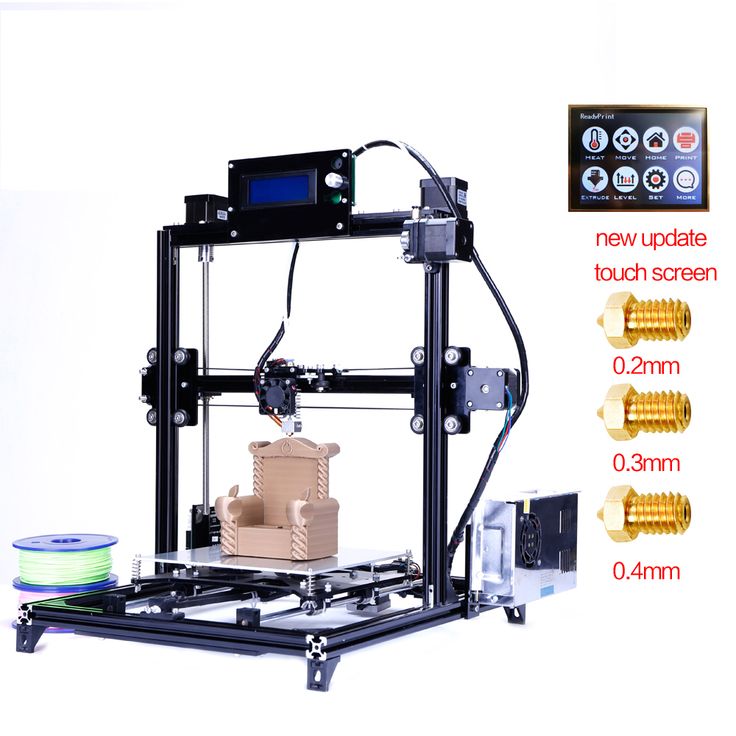 FlashForge Adventurer 3 FlashForge Adventurer 3. Photo: market-yandex.ru
FlashForge Adventurer 3 FlashForge Adventurer 3. Photo: market-yandex.ru 





